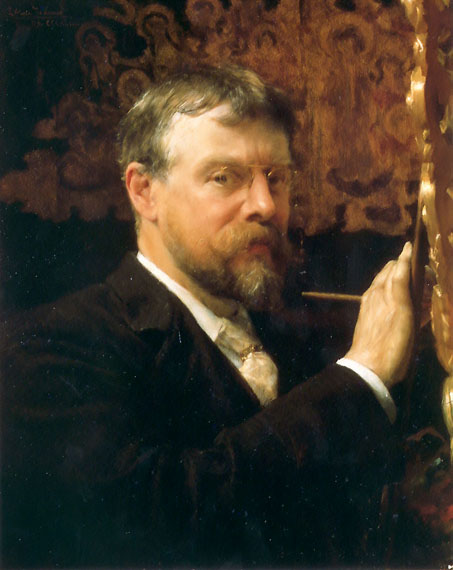
Netherlands Academic Painter and Draftsman
1836 - 1912

Born in Dronrijp, the Netherlands, and trained at the Academy of Antwerp, Belgium, he settled in England in 1870 and spent the rest of his life there. A classical-subject painter, he became famous for his depictions of the luxury and decadence of the Roman Empire, with languorous figures set in fabulous marbled interiors or against a backdrop of dazzling blue Mediterranean Sea and sky.
Universally admired for his superb draftsmanship and depictions of Classical Antiquity, during his lifetime, he fell into disrepute after his death and only in the last thirty years has his work been reevaluated for its importance within nineteenth-century English art.
Sir Lawrence Alma-Tadema was born as Laurens Tadema on January 8, 1836, in the small village of Dronrijp, in Friesland in the north of the Netherlands. He was the sixth child of Pieter Jiltes Tadema. The Tadema family moved in 1838 to the near town of Leeuwarden, where Pieter's position as a notary would be more lucrative. His father died when Laurens was four, leaving his mother with five children: Laurens, his sister, and three boys from his father's first marriage. His mother had artistic leanings, and decided that drawing lessons should be incorporated into the children's education. He received his first art training with a local drawing master hired to teach his older half-brothers.
It was intended that the boy would become a lawyer; but in 1851 at the age of fifteen he suffered a physical and mental breakdown. Diagnosed as consumptive; given only a short time to live, he was allowed to spend his remaining days at his leisure, drawing and painting. Left to his own devices he regained his health and decided to pursue a career as an artist. In 1852 he entered The Royal Academy of Antwerp where he studied early Dutch and Flemish art, under Egide Charles Gustave Wappers. During Alma-Tadema's four years as a registered student at the Academy, he won several respectable awards.
Before leaving school, towards the end of 1855, he became an assistant to the painter and professor Louis Jan de Taeye, whose courses in history and historical costume he had greatly enjoyed at the Academy. Although de Taeye was not an outstanding painter, Alma-Tadema respected him and became his studio assistant working with him for three years. De Taeye introduced him to books that influenced his desire to portray Merovingian subjects early in his career. He was encouraged to depict historic accuracy in his paintings, a trait for which the artist became known. Alma-Tadema left Taeye's studio in November of 1858 returning to Leeuwarden before settling in Antwerp, where he began working with the painter Baron Jan August Hendrik Leys, whose studio was one of the most highly regarded in Belgium. Under his guidance Alma-Tadema painted his first major work: The Education of the Children of Clovis (1861). This painting created a sensation among critics and artists when it was exhibited that year at the Artistic Congress in Antwerp. It is said to have laid the foundation of his fame and reputation. Alma-Tadema related that although Leys thought the completed painting better than he had expected, he was critical of the treatment of marble, which he compared to cheese. Alma-Tadema took this criticism very seriously, and it led him to improve his technique and to become the world's foremost painter of marble and variegated granite. Despite any reproaches from his master, The Education of the children of Clovis was honorably received by critics and artists alike and was eventually purchased and subsequently given to King Leopold of Belgium.
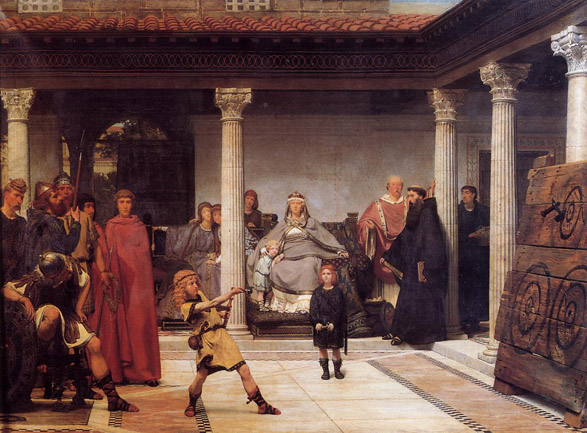
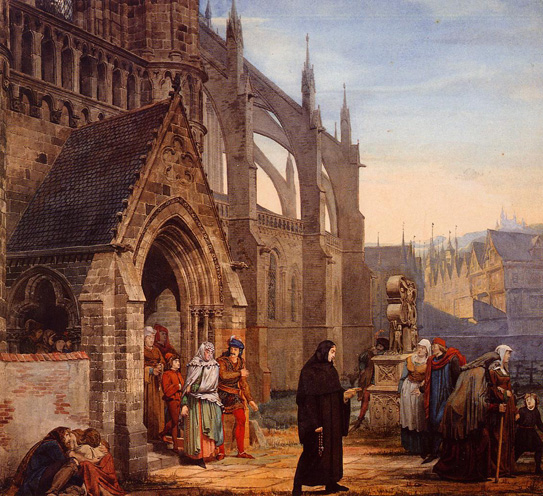
Faust was the drama by Goethe on which he worked since 1770 till 1832. First part was finished in 1808. Mephistopheles challenges the Lord he could ruin the soul of Faust. Mephistopheles tries to satisfy Faust's different desires, culminating in the incident with Gretchen (Margaret), whom Faust seduces, bringing about her miserable death.
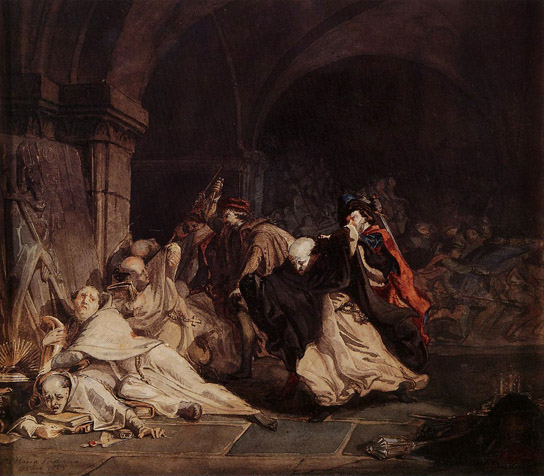
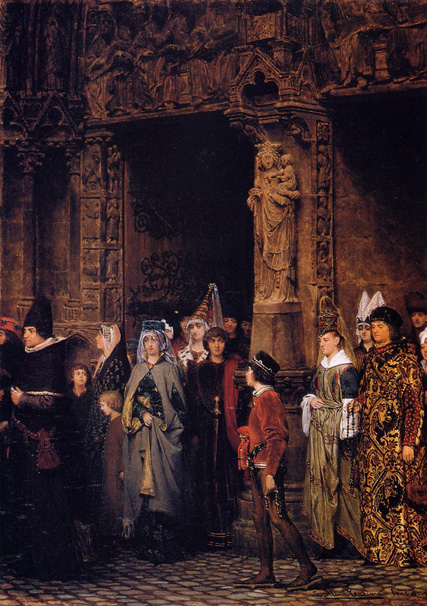
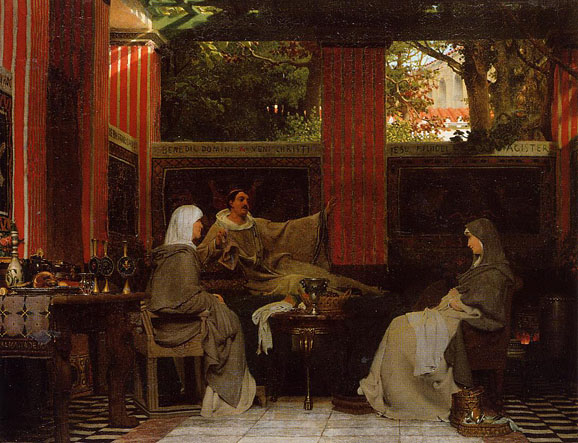
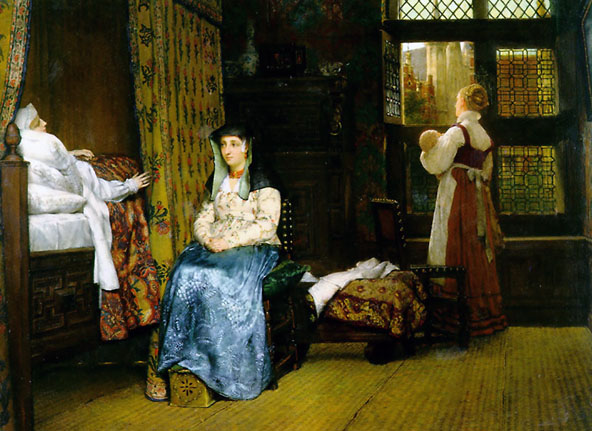
Merovingian themes were the painter's favorite subject up to the mid-1860's. It is perhaps in this series that we find the artist moved by the deepest feeling and the strongest spirit of romance. However Merovingian subjects did not have a wide international appeal, so he switched to themes of life in Ancient Egypt that were more popular. On these scenes of Frankish and Egyptian life Alma-Tadema spent great energy and much research. In 1862 Alma-Tadema left Leys's studio and started his own career, establishing himself as a significant classical-subject European artist.
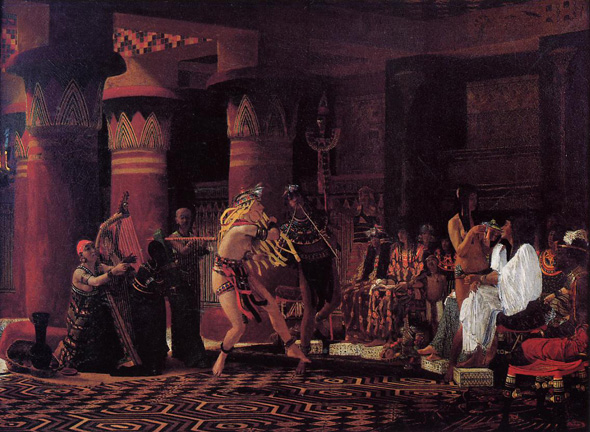
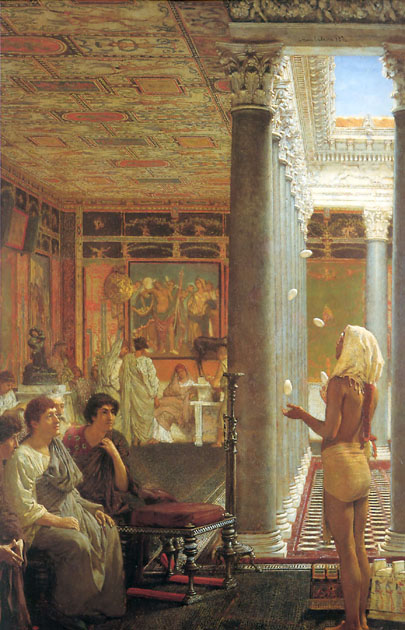
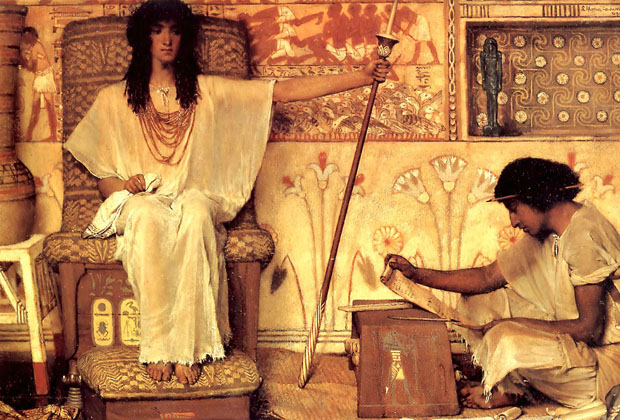
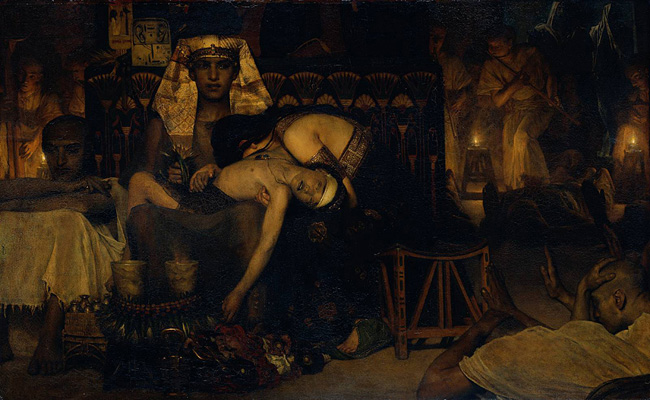
1863 was to alter the course of Alma-Tadema's personal and professional life: on January 3 his invalid mother died, and on September 24 he was married, in Antwerp City Hall, to Marie-Pauline Gressin, the daughter of Eugene Gressin, a French journalist of royal descent living near Brussels. Nothing is known of their meeting and little of Pauline herself, as Alma-Tadema never spoke about her after her death in 1869. Her image appears in a number of oils, though he painted her portrait only three times, the most notable appearing in My studio (1867). The couple had three children. Their eldest and only son lived only a few months dying of smallpox. Their two daughters, Laurence (1864-1940) and Anna (1867-1943), both had artistic leanings: the former in literature, the latter in art. Neither would marry.
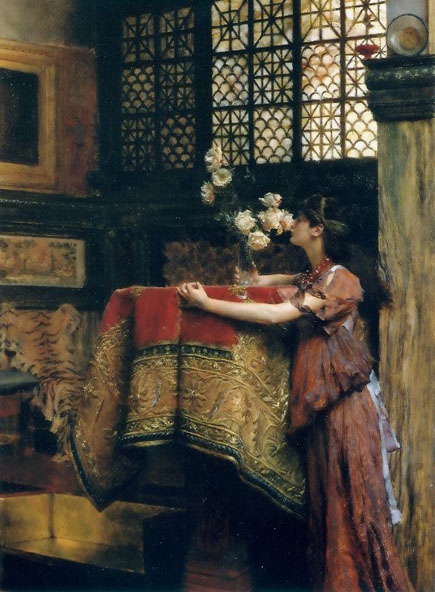
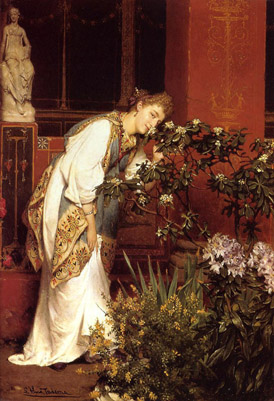
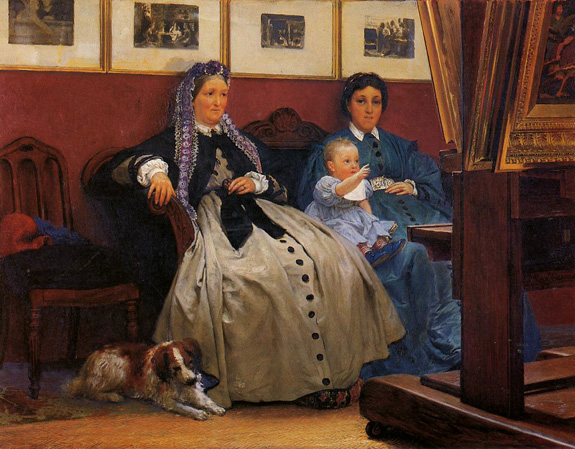
Alma-Tadema and his wife spent their honeymoon in Florence, Rome, Naples and Pompeii. This, his first visit to Italy, developed his interest in depicting the life of ancient Greece and Rome, especially the latter since he found new inspiration in the ruins of Pompeii, which fascinated him and would inspire much of his work in the coming decades.
During the summer of 1864, Tadema met Ernest Gambart, the most influential art dealer and impresario of the nineteenth century. Gambart was very impressed with the work of Tadema, who was then painting: Egyptian Chess Players (1865). The dealer recognizing at once the unusual gifts of the young painter: he gave him an order for twenty-four pictures and arranged for three of Tadema's paintings to be shown in London. In 1865, Tadema relocated to Brussels where he was named a Knight of the Order of Leopold I.
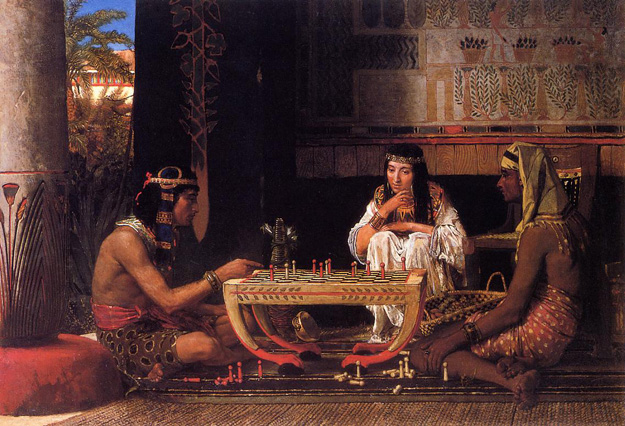
On May 28 1869, after years of ill health, Pauline died at Schaerbeek, in Belgium, at the age of thirty-two, of smallpox. Her death left Tadema inconsolable and depressed. He ceased painting for nearly four months. His sister Artje, who lived with the family, helped with the two daughters then aged five and two. Artje took over the role of housekeeper and remained with the family until 1873 when she married.
During the summer Tadema himself began to suffer from a medical problem which doctors in Brussels were frustratingly unable to diagnose. Gambart eventually advised him to go to England for another medical opinion. Soon after his arrival in London in December 1869, Alma-Tadema was invited to the home of the painter Ford Maddox Brown. There he met the seventeen years old Laura Theresa Epps and fell in love with her at first sight.
The outbreak of the Franco Prussian War in July 1870 compelled Alma-Tadema to leave the continent and move to London. His infatuation with Laura Epps played a great part in his relocation to England and Gambart felt that the move would be advantageous to the artist's career. In stating his reasons for the move, Tadema simply said: "I lost my first wife, a French lady with whom I married in 1863, in 1869. Having always had a great predilection for London, the only place where, up till then my work had met with buyers, I decided to leave the continent and go to settle in England, where I have found a true home."
With his small daughters and sister Artje, Alma-Tadema arrived in London at the beginning of September 1870. The painter wasted no time in contacting Laura, and it was arranged that he would give her painting lessons. During one of these, he proposed marriage. As he was then thirty-four and Laura was now only eighteen, her father was initially opposed to the idea. Dr Epps finally agreed on the condition that they should wait until they knew each other better. They married in July 1871. Laura, under her married name, also won a high reputation as an artist, and appears in numerous of Alma-Tadema's canvases after their marriage (The Women of Amphissa (1887) being a notable example). This second marriage was enduring and happy, though childless, and Laura became stepmother to Anna and Laurence.
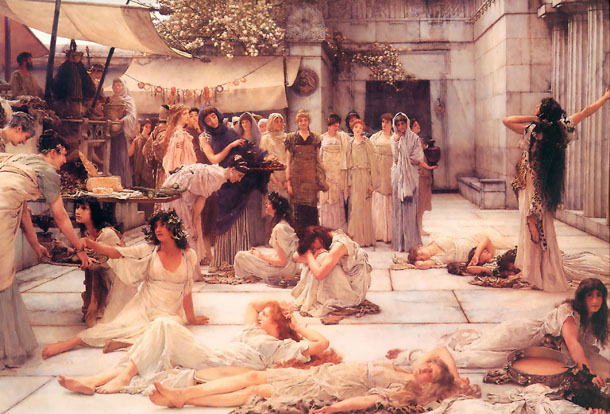
In 1873 Alma-Tadema became the last denizen. The previous year he and his wife made a journey on the Continent that lasted five and a half months and took them through Brussels, Germany, and Italy. In Italy they were able to take-in the ancient ruins again; this time he purchased several photographs, mostly of the ruins, which began his immense collection of folios with archival material sufficient for the documentation used in the completion of future paintings. In January 1876, he rented a studio in Rome. The family returned to London in April, visiting the Parisian Salon on their way back.
Among the most important of his pictures during this period was An Audience at Agrippa's (1876). When an admirer of the painting offered to pay a substantial sum for a painting with a similar theme, Alma-Tadema simply turned the emperor around to show him leaving in After the Audience.
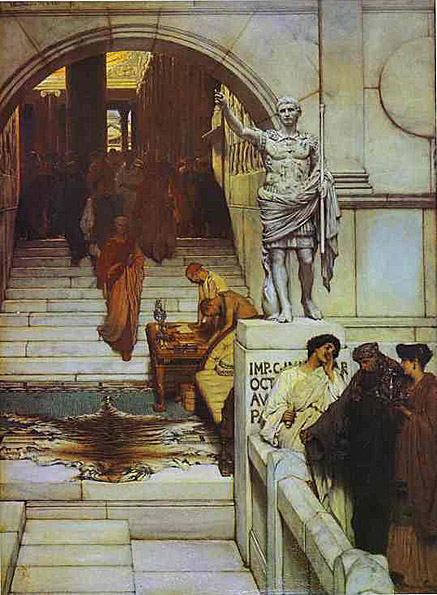
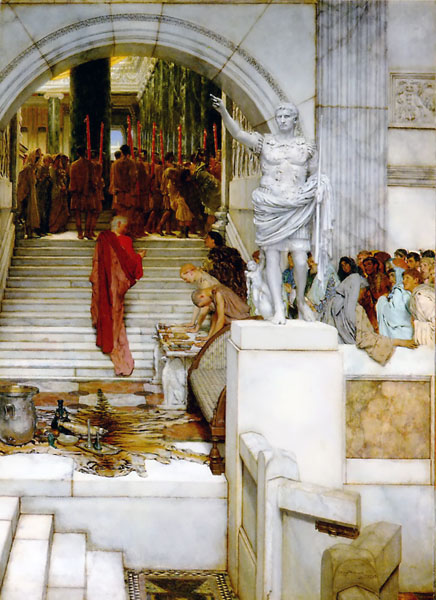
In 1883 he returned to Rome and, most notably, Pompeii, where further excavations had taken place since his last visit. He spent a significant amount of time studying the site, going there daily. These excursions gave him an ample source of subject matter as he began to further his knowledge of daily Roman life. At times, however, he integrated so many objects into his paintings that some said they resembled museum catalogues.
One of his most famous paintings is The Roses of Heliogabalus (1888) - based on an episode from the life of the infamously debauched Roman Emperor Elagabalus (Heliogabalus), the painting depicts the psychopathic Emperor suffocating his guest at an orgy under a cascade of rose petals. The blossoms depicted were sent weekly to the artist's London studio from the Riviera for four months during the winter of 1887- 1888.
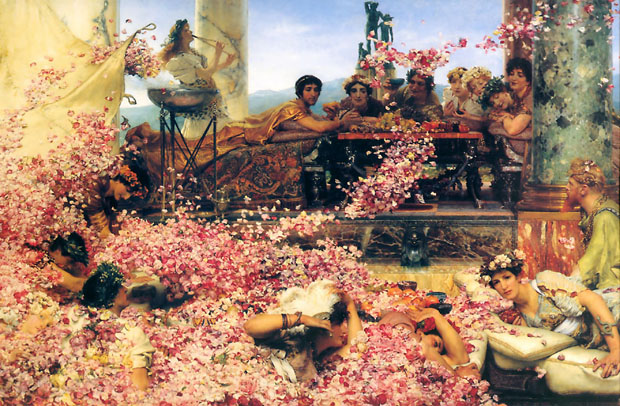
Fin de siecle also is the subject, if not the treatment, of Alma-Tadema's delicately wrought masterpiece The Roses of Heliogabalus. There is no known connection between the poem and the painting other than the choice of the same incident from the life of 3rd century Roman emperor Heliogabalus (Varius Avitus Bassus). The episode is that of Heliogabalus literally (and fatally) smothering his guests in a shower of rose-petals. Alma-Tadema, unlike Smith, has eschewed the morbid connotations of this subject and focused more on the frolicsome pleasures of the Roman aristocracy. Frolicsome was not the process of painting this piece, which took some time and labor, with Tadema having to import roses out of season.
C.A. Smith's poem is an interesting counterpart to Alma-Tadema's painting as it focuses more on the personality of the emperor, who is seen as something of a decadent aesthete. An exhaustive search has not turned up an individual called 'Christophe des Laurières', and is assumed by this author to be Clark Ashton Smith writing with a pseudonym.
Heliogabalus
Clark Ashton Smith
Translated from Christophe des Laurières
He, the supreme idealist of Sin,
Through scarlet days a white perfection sought -
To make of lyric deed and lyric thought
One music of perverse accord, wherein
The songless blatancy and banal din
Of all the world should perish: he had wrought
From Vice a pure, Pentelic Venus, fraught
With lines of light and terror, that should win
The plaudits of the stars. . . . But prevalent
For him, above the achievable desire,
And Life perfectible by Sin and Art,
Such lusts as leave the Titans impotent
Allured, and Life and Sin, in worlds apart,
Were fair with suns of quintessential fire.
Among Alma-Tadema's works of this period are: An Earthly Paradise (1891), Unconscious Rivals (1893) Spring (1894), The Coliseum (1896) and The Baths of Caracalla (1899). Although Alma-Tadema fame rests on his paintings set in Antiquity, he also painted portraits, landscapes and watercolors, and made some etchings himself (although many more were made of his paintings by others).
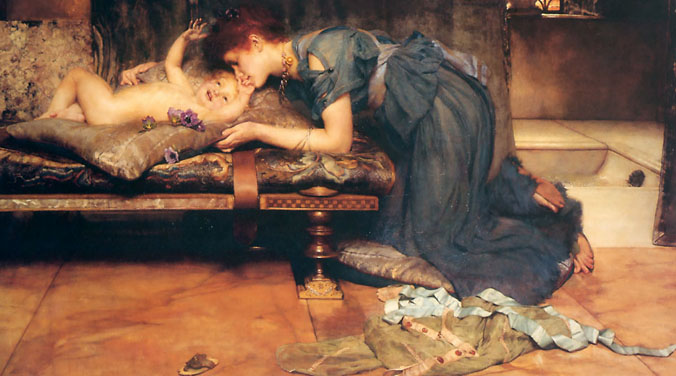
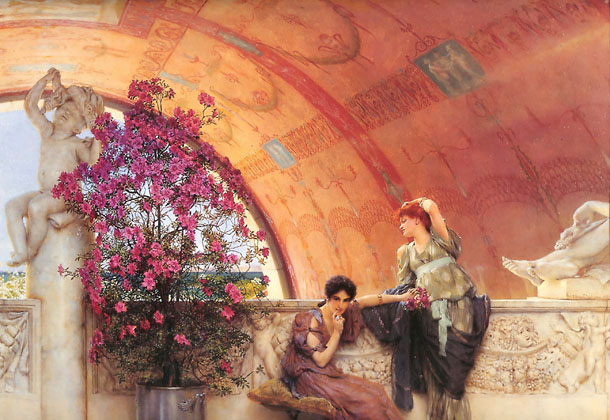
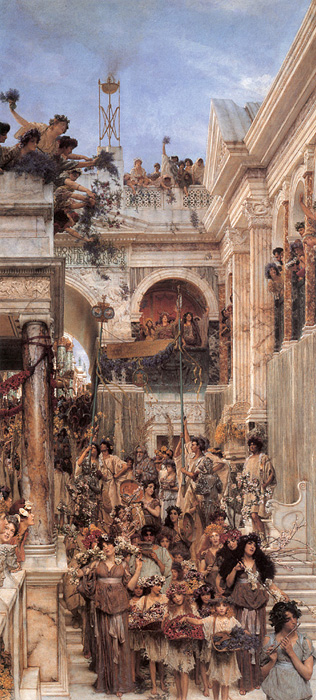
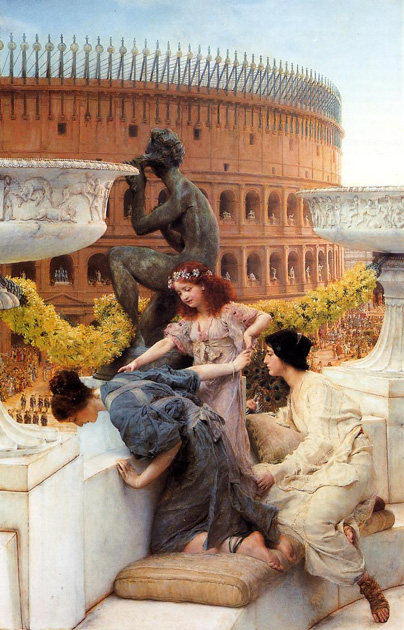
Occupying a site just east of the Roman Forum, its construction started between 70 and 72 AD under the emperor Vespasian and was completed in 80 AD under Titus, with further modifications being made during Domitian's reign (81-96).[1] The name "Amphitheatrum Flavium" derives from both Vespasian's and Titus's family name (Flavius, from the gens Flavia).
Originally capable of seating around 50,000 spectators, the Colosseum was used for gladiatorial contests and public spectacles. It remained in use for nearly 500 years with the last recorded games being held there as late as the 6th century. As well as the traditional gladiatorial games, many other public spectacles were held there, such as mock sea battles, animal hunts, executions, re-enactments of famous battles, and dramas based on Classical mythology. The building eventually ceased to be used for entertainment in the early medieval era. It was later reused for such varied purposes as housing, workshops, and quarters for a religious order, a fortress, a quarry and a Christian shrine.
Although it is now in a ruined condition due to damage caused by earthquakes and stone-robbers, the Colosseum has long been seen as an iconic symbol of Imperial Rome. Today it is one of modern Rome's most popular tourist attractions and still has close connections with the Roman Catholic Church, as each Good Friday the Pope leads a torch lit "Way of the Cross" procession to the amphitheatre.
In 7th century Beda said: "As long as the Coliseum stands, Rome will stand as well; when the Coliseum falls, Rome will fall and when Rome falls, the end of the world will follow".
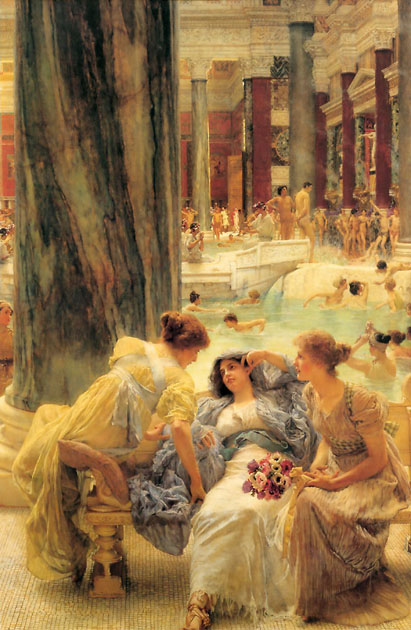
By the 3rd century A.D. the Romans had built many baths, in Rome and elsewhere, and had acquired great skill in designing functional, fully integrated complexes. The water supply and drainage system, in particular, required careful planning to ensure an adequate flow to and from the numerous hot and cold basins: it has been calculated that the baths used 15-20,000 cubic meters of water per day.
The baths were fed by a branch of the Aqua Marcia Aqueduct, which brought pure water to Rome from springs in the hills near Subiaco, over 90 km away. The water flowed into a huge cistern, divided into 18 separate chambers for easy maintenance and with a total capacity of 80,000 cu. m. From here it went by gravity flow through pipes underneath the gardens to the main building.
Inside the main building a complicated distribution system carried the water directly to the cold pools or to boilers over wood fires where it was heated for the warm and hot baths. Outlets from each basin and in the floor of each room led to the drains, which ran below the level of the distribution pipes and took the waste water to the municipal drain in the valley. Both distribution and drainage pipes were housed in tunnels providing easy access for inspection and maintenance. A third network of tunnels was used to store the enormous amounts of wood required to fuel the furnaces (praefurnia): there were at least fifty of these, some to heat the water and others to heat the rooms by a hot air system beneath the floor (hypocausta).
The heated rooms were on the south-western side of the building. The hottest room of all, the calidarium, projected beyond the line of the building to take full advantage of the sun's rays. Hollow terracotta tubes ran inside the walls to provide insulation and channel hot air. The main building was built to a symmetrical plan similar to that of other baths of imperial Rome (see below). Someone using the facilities would first enter one of the dressing-rooms (apodyteria) (A), where he could undress and place his clothes on a shelf. Then he might take some exercise in the gymnasium (palaestra) (B) or have a massage in one of the small rooms leading off it. He would proceed to the heated rooms for a sauna or the equivalent of a Turkish bath in the calidarium (C). He then went through the tepidarium (D) to the large, unheated hall called a frigidarium (E), which was open on one side giving access to the open-air swimming-pool (natatio) (F). Then he could return to the dressing-room to get his clothes.
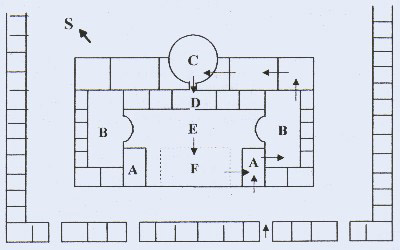
The Thermae were like a modern leisure center: there were gardens surrounding the main building where people could walk and meet their friends, libraries, multi-purpose halls and a small outdoor stadium (which used the steps up to the cistern as a stand). Around the perimeter of the site were rooms used as shops, bars or brothels: renting these out probably helped to cover costs, as entrance to the baths was free. The building was sumptuously decorated with statues and mosaics, but unfortunately only a few fragments are still in place.
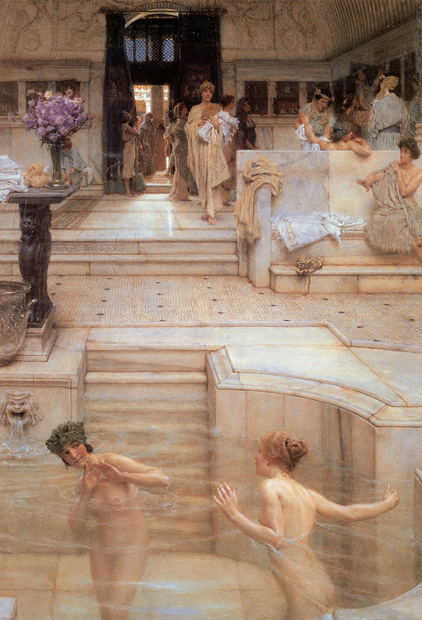
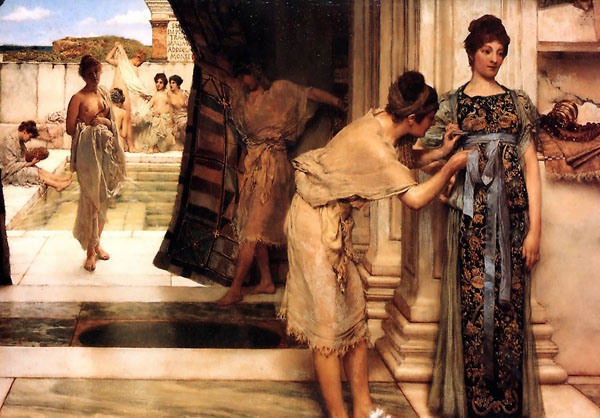
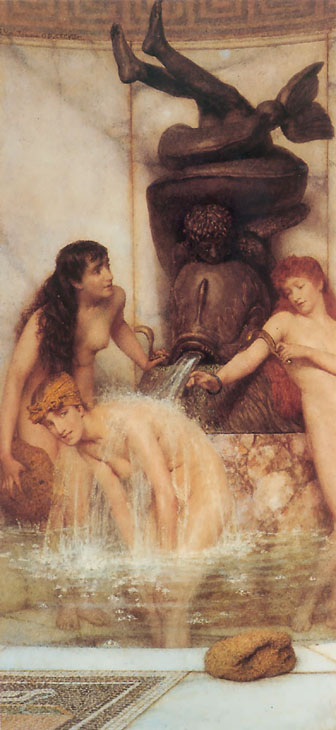
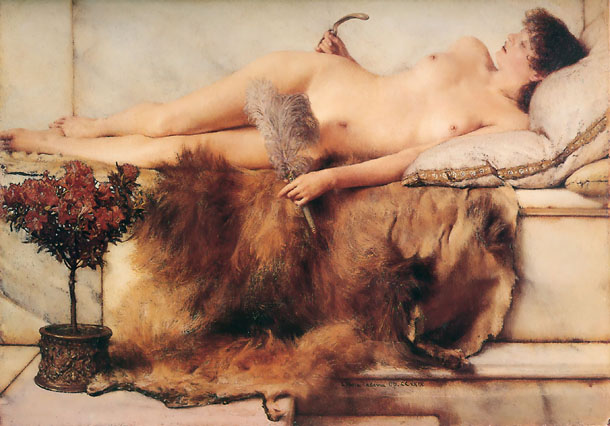
.jpg)
Alma-Tadema's output decreased with time, due in part to ill health but also to his obsession for decorating his new home where he moved in 1883. Nevertheless, he continued to exhibit throughout the 1880s and into the next decade, receiving a plentiful amount of accolades along the way, including the medal of Honor at the Paris Exposition Universelle of 1889, election to an honorary member of the Oxford University Dramatic Society in 1890, the Great Gold Medal at the International Fine Arts Exposition in Brussels of 1897. In 1899 he was Knighted in England, only the eighth artist from the Continent to receive the honor. Not only did he assist with the organization of the British section at the 1900 Exposition Universelle in Paris, he also exhibited two works that earned him the Grand Prix Diploma. He also assisted with the St. Louis World's Fair of 1904 where he was well represented and received.
During this time, Alma-Tadema was very active with theater design and production, designing many costumes. He also spread his artistic boundaries and began to design furniture, often modeled after Pompeian or Egyptian motifs, illustrations, textiles, and frame making. His diverse interests highlight his immense talents. Each of these exploits were used in his paintings, as he often incorporated some of his designed furniture into the composition, and must have used many of his own designs for the clothing of his female subjects. Through his last period of creativity Alma-Tadema continued to produce paintings, which repeat the successful formula of women in marble terraces overlooking the sea such as in Silver Favorites (1903). Between 1906 and his death six years later, Alma-Tadema painted less but still produced ambitions paintings like The Finding of Moses (1904).
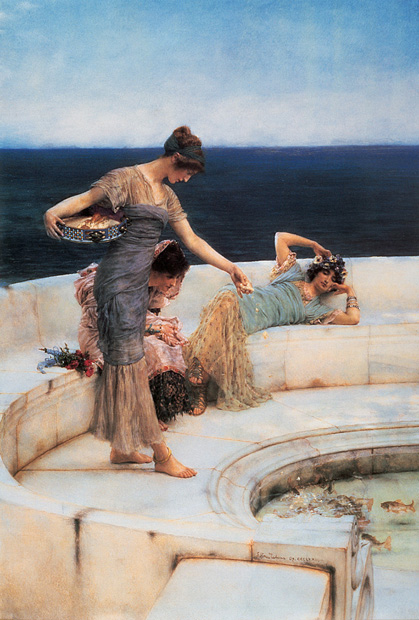
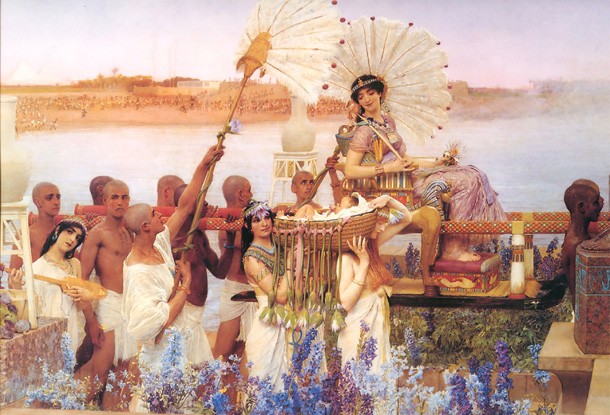
On 15 August 1909 Alma-Tadema's wife, Laura, died at the age of fifty-seven. The grief-stricken widower outlived his second wife for less than three years. His last major composition was Preparation in the Coliseum (1912). In the summer of 1912, Alma Tadema was accompanied by his daughter Anna to Kaiserhof Spa, Wiesbaden, Germany where he was to undergo treatment for ulceration of the stomach. He died there on June 28, 1912 at the age of seventy-six. He was buried in a crypt in St. Paul's cathedral in London.
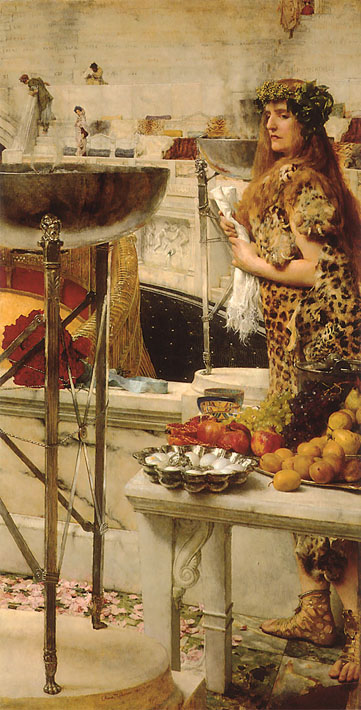
Sir Lawrence Alma-Tadema was arguably the most successful painter of the Victorian era. For over sixty years he gave his audience exactly what they wanted: distinctive, elaborate paintings of beautiful people in classical settings. His incredibly detailed reconstructions of ancient Rome, with languid men and women posed against white marble in dazzling sunlight provided his audience with a glimpse of a world of the kind they might one day construct for themselves at least in attitude if not in detail.
Being a creature of his time, when the Victorian period ended so did his marketability. By the end of his career, art such as Alma-Tadema's was no longer appreciated as it had been before. New movements in art had begun and his imagery, which was thought of as "Victorians in Togas," fell out of favor. The end of Alma-Tadema's life saw the rise of Post-Impressionism, Fauvism, Cubism and Futurism, of which he heartily disapproved. As his pupil John Collier wrote, 'it is impossible to reconcile the art of Alma-Tadema with that of Matisse, Gauguin and Picasso.
Paintings which once would have sold for £10,000 a few years earlier were now practically impossible to sell at all. Some of his paintings could have been purchased for as little as £20 at that time. His artistic legacy almost vanished. As attitudes of the public in general and the artists in particular became more skeptical of the possibilities of human achievement, his paintings were increasingly denounced. He was declared "the worst painter of the 19th century" by John Ruskin, and one critic even remarked that his paintings were "about worthy enough to adorn bourbon boxes." After this brief period of being actively derided, he was consigned to relative obscurity for many years. Only in the last thirty years has Alma-Tadema's work been reevaluated for its importance within the nineteenth century, and more specifically, within the evolution of English art.
He is now regarded as one of the principal classical-subject painters of the nineteenth century whose works demonstrate the care and exactitude of an era mesmerized by trying to visualize the past, some of which was being recovered through archaeological research.
Alma-Tadema's meticulous archaeological research, including research into Roman architecture (which was so thorough that every building featured in his canvases could have been built using Roman tools and methods) led to his paintings being used as source material by Hollywood directors in their vision of the ancient world for films such as D. W. Griffith's Intolerance (1916), Ben Hur (1926), Cleopatra (1934), and most notably of all, Cecil B. DeMille's epic remake of The Ten Commandments (1956). Indeed, Jesse Lasky Jr., the co-writer on The Ten Commandments, described how the director would customarily spread out prints of Alma-Tadema paintings to indicate to his set designers the look he wanted to achieve. The designers of the Oscar-winning Roman epic Gladiator used the paintings of Alma-Tadema as a central source of inspiration.
In the late 1960s, the revival of interest in Victorian painting gained impetus, and a number of well-attended exhibitions were held. Allen Funt, the creator and host of the American version of the television show Candid Camera, was a collector of Alma-Tadema paintings at a time when the artist's reputation in the 20th century was at its nadir. After Funt was robbed by his accountant (who subsequently committed suicide), he was forced to sell his collection at Sotheby's in London in November 1973. From this sale, the interest in Alma-Tadema was re-awakened. In 1960, the Newman Gallery first tried to sell, then give away (without success) one of his most celebrated works 'The Finding of Moses,' (1904). The initial purchaser had paid £5250 for it on its completion, but when the same picture was auctioned at Christies in New York in May 1995, it sold for £1.75 million.
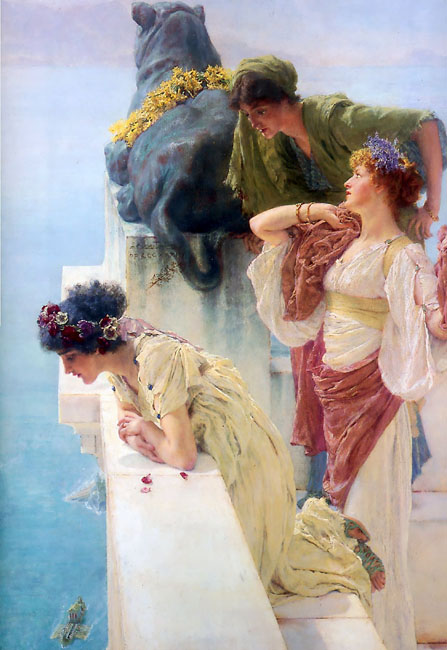
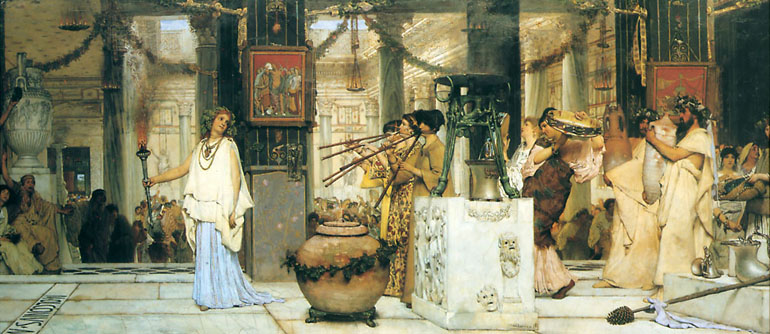
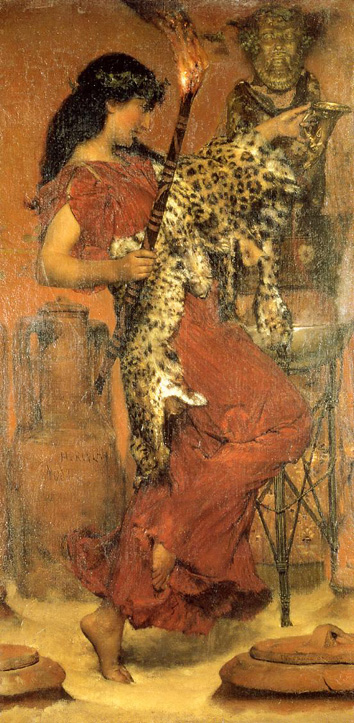
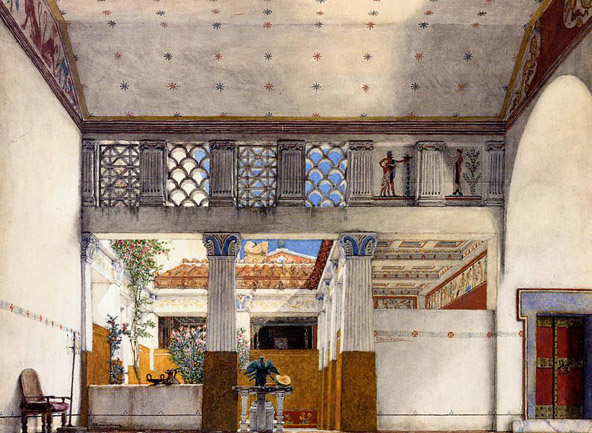
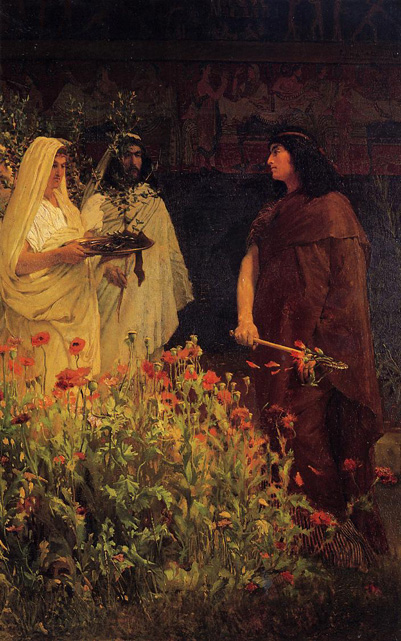
At the time his kingdom was one of the most powerful in Italy. Its capital had some 35,000 inhabitants, its territory was some 800 square kilometers, and its zone of influence stretched as far as Circeii and Terracina - 90 kilometers to the southeast. The Latin cities recognized Roman leadership, and Tarquin added several towns to his kingdom.
He continued with great vigor the work of extending the power of the city, and the founding of colonies by him was the beginning of Rome's path to supremacy of the world. Tarquin was responsible for the building of Capitoline Temple (Jupiter Capitolinus) and the Cloaca Maxima, the sewerage system that discharged into the Tiber. Tarquin concluded a treaty with Gabii, a town east of Rome. But on other matters Tarquinius was less politically astute. He irritated the people by the burdens he placed upon them. The heads of Rome's noble families had always been invited to give advice to the king. Those meetings were called the Senate. Tarquin behaved like an autocrat and was not interested in consulting the senators, those obviously felt ignored. Tarquinius surname Superbus means something like 'the haughty one' or 'the Proud.
According to Livy, a reign of terror followed, and many senators were put to death. Eventually a group of senators led by Lucius Junius Brutus (another Etruscan nobleman) raised a revolt. The romantic reason traditionally given for the deposition of Tarquin was the rape of Lucretia by his son Sextus Tarquinius. After the subsequent suicide of Lucretia, her husband, Lucius Tarquinius Collatinus, and the Brutus family (to which Lucretia belonged) raised a rebellion. The actual reason for the fall of the Monarchy was probably a power struggle between the king and the leading aristocratic families. Tarquin attempted to curb the rising power of the aristocrats by packing the Senate with 200 of their supporters, increasing the total membership to 300 men. These were known as the conscripti or the enrolled ones and this word became part of the official title of the Senate, the Patres Conscripti or Conscript Fathers. The Tarquin family was expelled from Rome, the monarchy at Rome was abolished and the Aristocracy set up a republic in 509 BCE.
Although the names, dates, and events of the regal period are considered as belonging to the realm of fiction and myth rather than to that of factual history, certain facts seem well attested: the existence of an early rule by kings; the growth of the city and its struggles with neighboring peoples; the conquest of Rome by Etruria and the establishment of a dynasty of Etruscan princes, symbolized by the rule of the Tarquins; the overthrow of this alien control; and the abolition of the kingship.
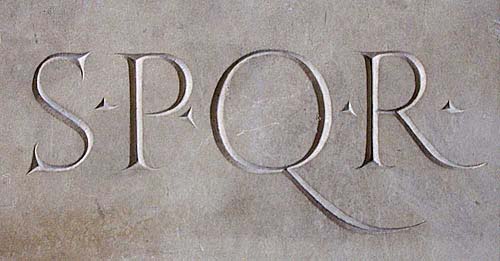
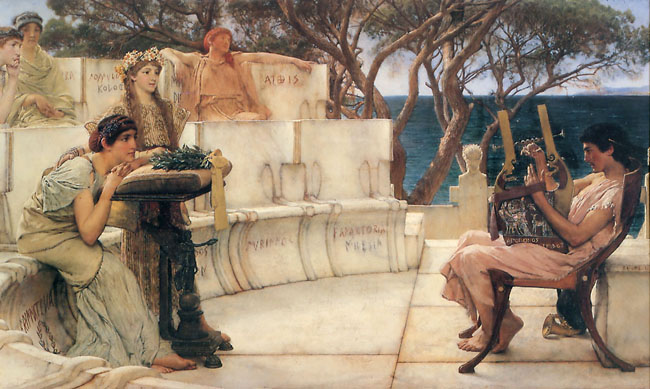
Lyric poetry was personal and evocative, allowing the reader to identify with the poet's private despair and hopes. It's for this reason that Sappho, even 2600 years later, can arouse our emotions. We know Sappho gathered about herself a group of women. The subjects of Sappho's poetry were herself, her friends and family, and their feelings for each other. She wrote about her brother (who seems to have led a dissolute life) and Alcaeus, but most of her poetry concerns the women in her life some of whom she loves passionately. In one poem she envies the husband of her friend. When Sappho looks at this friend, "her tongue will not move, a subtle fire burns under her skin, her eyes see no longer, her ears ring, she breaks into a sweat, she trembles, she is as pale as death which seem so near."
Sappho wrote about her friends leaving, getting married, pleasing and disappointing her, and imagining them remembering the old days. She also wrote epithalamia (marriage hymns), and a poem on the wedding of Hector and Andromache. Sappho did not write about the political struggles except to mention the difficulty she will have getting a hat given the current political situation. Ovid says she let fame console her for lack of physical beauty. According to legend, Sappho's death was consistent with her passionate personality. When a haughty man named Phaon spurned her, Sappho jumped from the cliffs of Cape Leucas into the sea.
Alcaeus
Only fragments remain of the work of Alcaeus, but Horace thought highly enough of it to pattern himself on Alcaeus and present a summary of the earlier poet's themes. Alcaeus writes of fighting, drinking (in his thinking, wine is the cure for almost everything), and love. As a warrior his career was marred by the loss of his shield. (To put that in context, remember the Spartan mother's advice to her son on his way to war: Return with your shield or on it.) He says little enough about politics except to indicate his contempt for democrats as would-be tyrants. He, too, comments on his physical appearance, in his case, the gray hair on his chest.
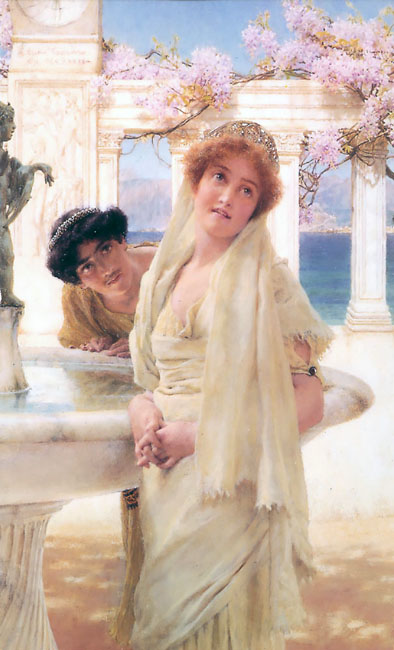
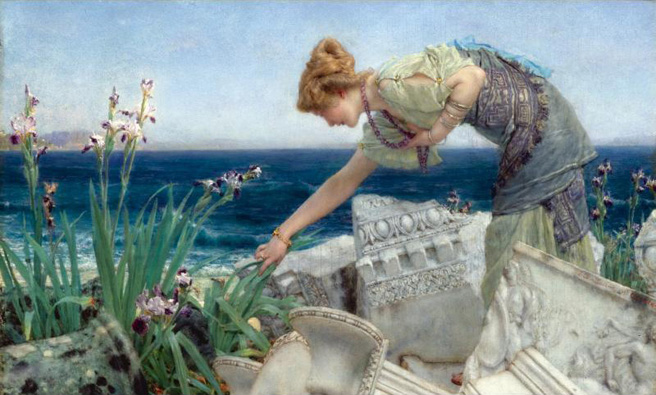
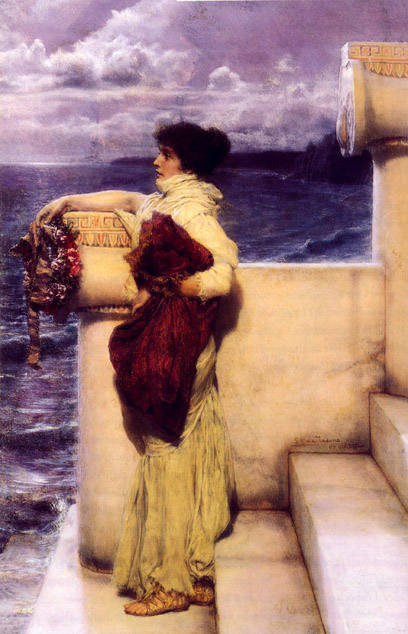
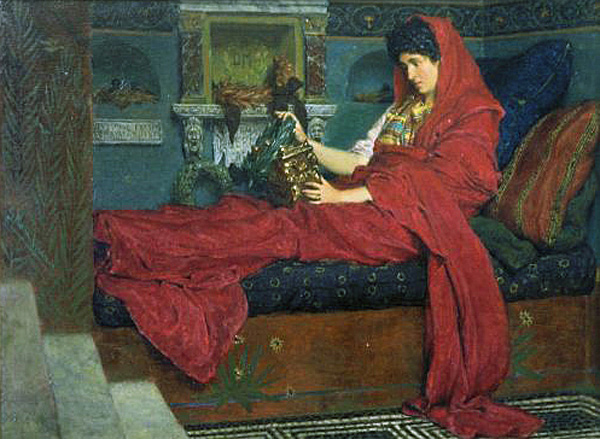
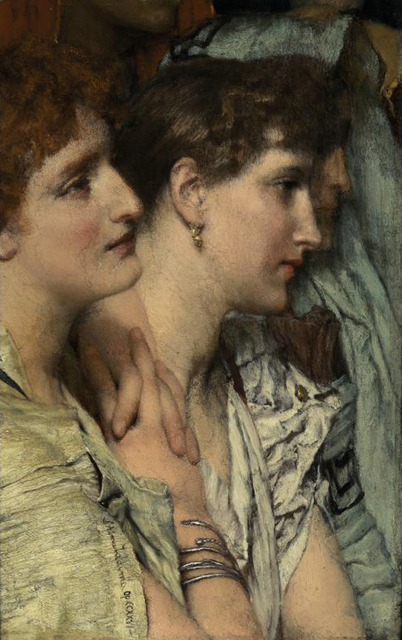
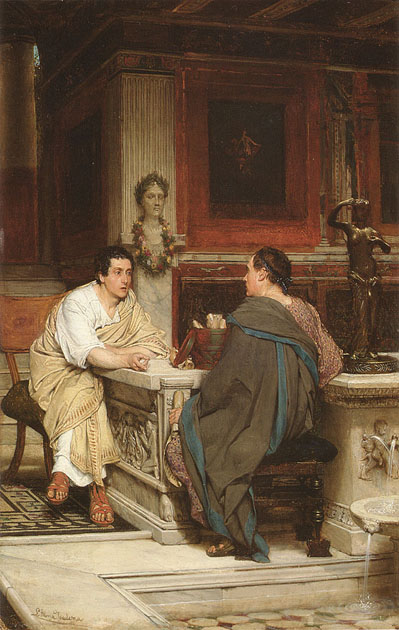
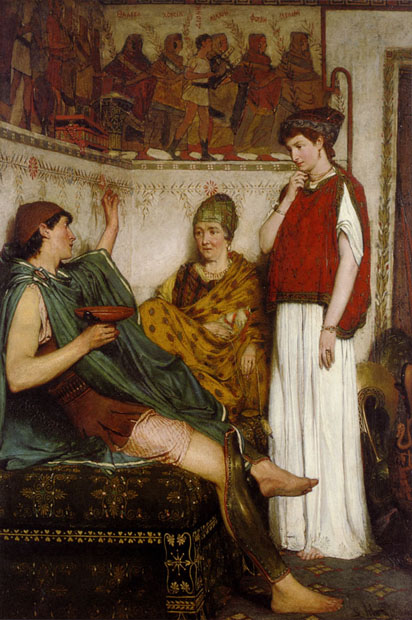
In September of 490 BC a Persian armada of 600 ships disgorged an invasion force of approximately 20,000 infantry and cavalry on Greek soil just north of Athens. Their mission was to crush the Greek states in retaliation for their support of their Ionian cousins who had revolted against Persian rule.
Undaunted by the numerical superiority of the invaders, Athens mobilized 10,000 hoplite warriors to defend their territory. The two armies met on the Plain of Marathon twenty-six miles north of Athens. The flat battlefield surrounded by hills and sea was ideal for the Persian cavalry. Surveying the advantage that the terrain and size of their force gave to the Persians, the Greek generals hesitated.
One of the Greek generals - Miltiades - made a passionate plea for boldness and convinced his fellow generals to attack the Persians. Miltiades ordered the Greek hoplites to form a line equal in length to that of the Persians. Then - in an act that his enemy believed to be complete madness - he ordered his Greek warriors to attack the Persian line at a dead run. In the ensuing melee, the middle of the Greek line weakened and gave way, but the flanks were able to engulf and slaughter the trapped Persians. An estimated 6,400 Persians were slaughtered while only 192 Greeks were killed.
The remaining Persians escaped on their ships and made an attempt to attack what they thought was an undefended Athens. However, the Greek warriors made a forced march back to Athens and arrived in time to thwart the Persians.
Known as the "Father of History", Herodotus wrote his description of the battle a few years after it occurred. We join his account as the Athenians arrive at the battleground and are joined by a force of approximately 1000 of their Plataean allies. The Greek military leaders split on whether they should immediately attack the invaders or wait for reinforcements:
"The Athenians were drawn up in order of battle in a sacred close belonging to Heracles, when they were joined by the Plataeans, who came in full force to their aid.
The Athenian generals were divided in their opinions. Some advised not to risk a battle, because they were too few to engage such a host as that of the Persians. Others were for fighting at once. Among these last was Miltiades. He therefore, seeing that opinions were thus divided, and that the less worthy counsel appeared likely to prevail, resolved to go to the polemarch (an honored dignitary of Athens), and have a conference with him. For the man on whom the lot fell to be polemarch at Athens was entitled to give his vote with the ten generals, since anciently the Athenians allowed him an equal right of voting with them. The polemarch at this juncture was Callimachus of Aphidnre; to him therefore Miltiades went, and said:
'With you it rests, Callimachus, either to bring Athens to slavery, or, by securing her freedom, to be remembered by all future generations. For never since the time that the Athenians became a people were they in so great a danger as now. If they bow their necks beneath the yoke of the Persians, the woes which they will have to suffer...are already determined. If, on the other hand, they fight and overcome, Athens may rise to be the very first city in Greece.'
'We generals are ten in number, and our votes are divided: half of us wish to engage, half to avoid a combat. Now, if we do not fight, I look to see a great disturbance at Athens which will shake men's resolutions, and then I fear they will submit themselves. But, if we fight the battle before any unsoundness shows itself among our citizens,...we are well able to overcome the enemy.'
'On you therefore we depend in this matter, which lies wholly in your own power. You have only to add your vote to my side and your country will be free - and not free only, but the first state in Greece. Or, if you prefer to give your vote to them who would decline the combat, then the reverse will follow.'
Miltiades by these words gained Callimachus; and the addition of the polemarch's vote caused the decision to be in favor of fighting.'"
The Battle Begins
Miltiades arranges the Greek line of battle so that it stretches the length of the opposing, and far superior, Persian army. Then, much to the surprise of the Persians, he orders the Greek warriors to charge headlong into the enemy line.
"The Athenians...charged the barbarians at a run. Now the distance between the two armies was little short of eight furlongs (approximately a mile) The Persians, therefore, when they saw the Greeks coming on at speed, made ready to receive them, although it seemed to them that the Athenians were bereft of their senses, and bent upon their own destruction; for they saw a mere handful of men coming on at a run without either horsemen or archers.
Such was the opinion of the barbarians; but the Athenians in close array fell upon them, and fought in a manner worthy of being recorded. They were the first of the Greeks, so far as I know, who introduced the custom of charging the enemy at a run, and they were likewise the first who dared to look upon the Persian garb, and to face men clad in that fashion. Until this time the very name of the Persians had been a terror to the Greeks to hear.
The two armies fought together on the plain of Marathon for a length of time; and in the mid-battle the barbarians were victorious, and broke and pursued the Greeks into the inner country; but on the two wings the Athenians and the Plataeans defeated the enemy. Having so done, they suffered the routed barbarians to fly at their ease, and joining the two wings in one, fell upon those who had broken their own center, and fought and conquered them. These likewise fled, and now the Athenians hung upon the runaways and cut them down, chasing them all the way to the shore, on reaching which they laid hold of the ships and called aloud for fire."
The Persians Attack Athens
Miltiades arranges the Greek line of battle so that it stretches the length of the opposing, and far superior, Persian army. Then, much to the surprise of the Persians, he orders the Greek warriors to charge headlong into the enemy line.
"...the Athenians secured in this way seven of the vessels; while with the remainder the barbarians pushed off, and taking aboard their Eretrian prisoners from the island where they had left them, doubled Cape Sunium, hoping to reach Athens before the return of the Athenians.
The Persians accordingly sailed round Sunium. But the Athenians with all possible speed marched away to the defense of their city, and succeeded in reaching Athens before the appearance of the barbarians...The barbarian fleet arrived, and lay to off Phalerum, which was at that time the haven of Athens; but after resting awhile upon their oars, they departed and sailed away to Asia."
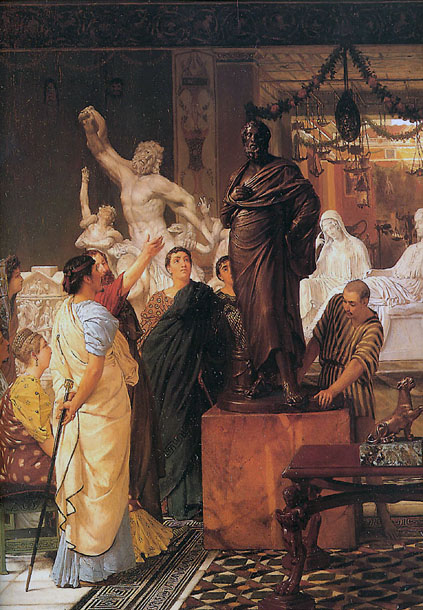
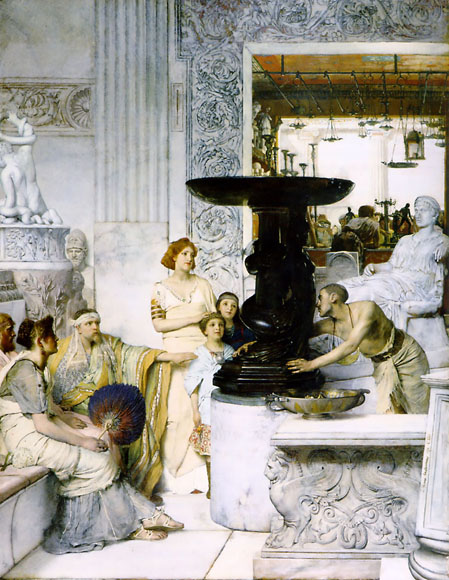
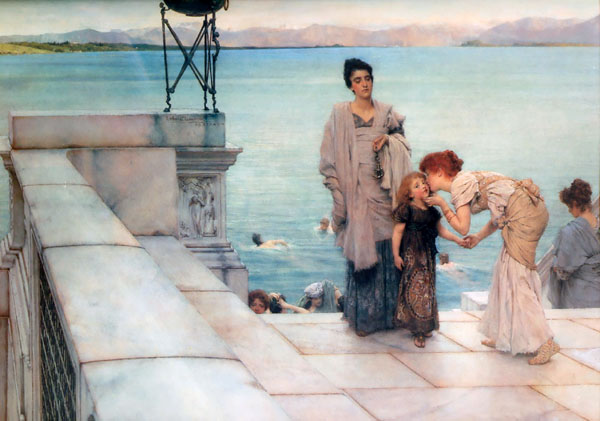
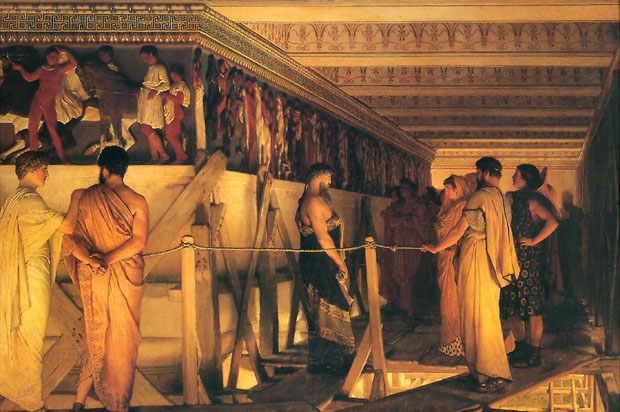
Phidias designed the statues of the goddess Athena on the Athenian Acropolis (Athena Parthenos inside the Parthenon and the Athena Promachos) and the colossal seated Statue of Zeus at Olympia in the 5th century BC. The Athenian works were apparently commissioned by Pericles in 447 BC. Pericles used the money from the maritime League of Delos to pay Phidias for his work.
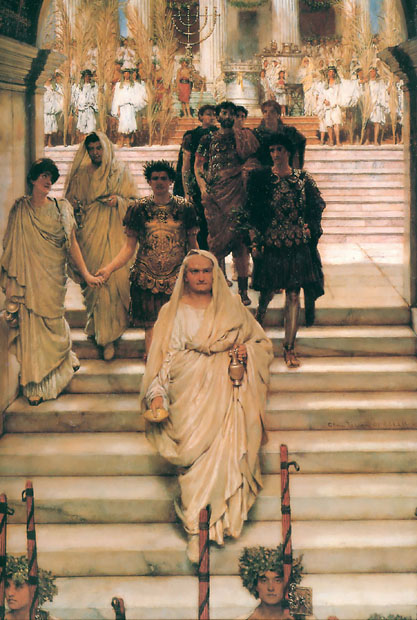
Prior to becoming emperor, Titus gained renown as a military commander, serving under his father in Judaea during the First Jewish-Roman War, which was fought between 67 and 70. The campaign came to a brief halt with the death of Emperor Nero on June 9, 68, launching Vespasian's bid for the imperial power during the Year of the Four Emperors. When Vespasian was declared emperor on December 21, 69, Titus was left in charge of ending the Jewish rebellion, which he did in 70, successfully besieging and destroying the city and the Temple of Jerusalem. For this achievement Titus was awarded a triumph; the Arch of Titus commemorates his victory to this day.
Under the rule of his father, Titus gained infamy in Rome serving as prefect of the Roman imperial bodyguard, known as the Praetorian Guard, and for carrying on a controversial relationship with the Jewish queen Berenice of Cilicia. Despite concerns over his character, however, Titus ruled to great acclaim following the death of Vespasian on June 23, 79, and was considered a good emperor by Suetonius and other contemporary historians. In this role he is best known for his public building program in Rome-completing the Flavian Amphitheatre, otherwise known as the Colosseum- and for his generosity in relieving the suffering caused by two disasters, the Mount Vesuvius eruption of 79 and the fire of Rome of 80. After barely two years in office, Titus died of a fever on September 13, 81. He was deified by the Roman Senate and succeeded by his younger brother Domitian.
The Arch of Titus shows Titus himself participating in the triumphal procession, riding a chariot and accompanied by allegorical figures: winged Victory, a goddess leading the horses, and the Genius of the People.
The Arch of Titus is located on the highest point of the Via Sacra, a road leading to the Roman Forum. This arch commemorates Titus' victorious conquest of Judaea, ending the Jewish Wars and leading the sacking of Jerusalem. The arch was constructed after Titus's death in 81 CE and, hence, after his becoming a god. It was probably built by this brother and successor, Emperor Domitian but some believe that it was actually built by Emperor Trajan because of similarities to the Arch of Trajan located at Benevento.
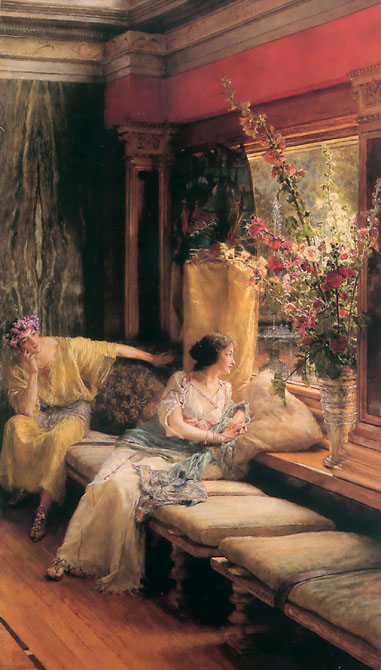
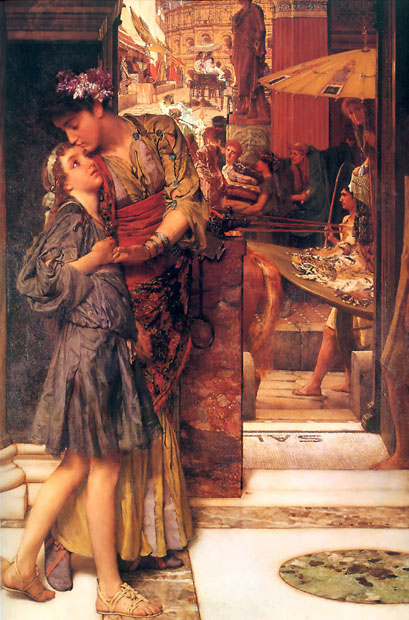
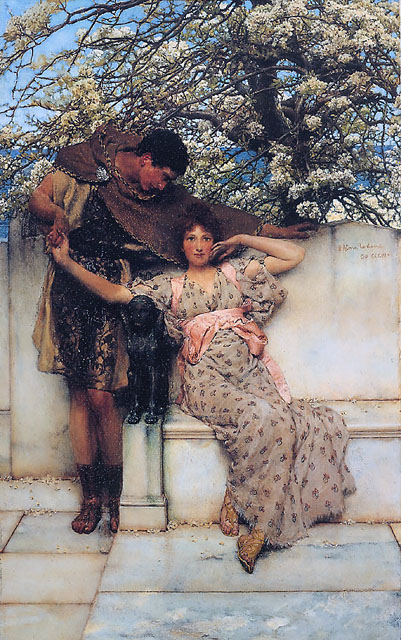
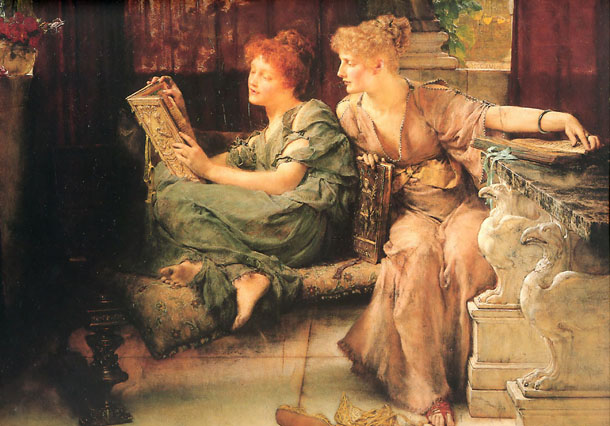

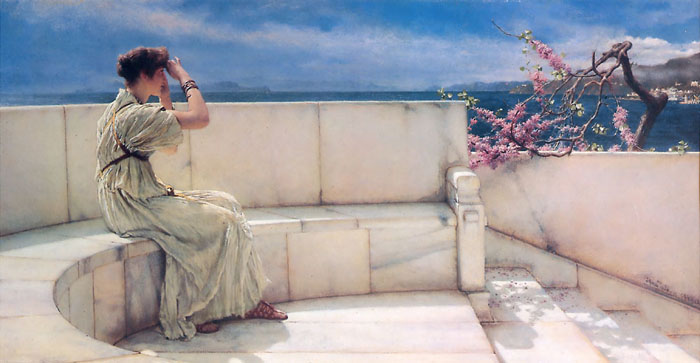
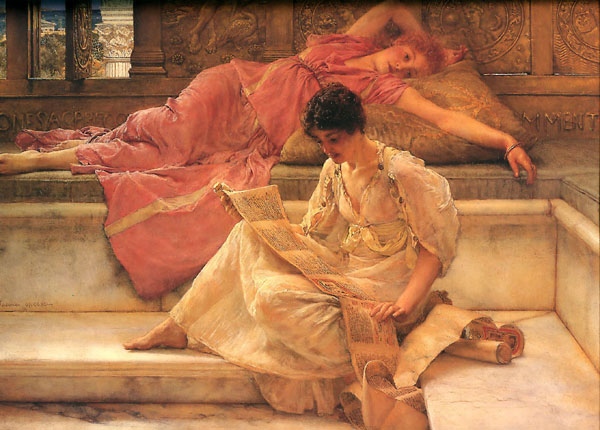
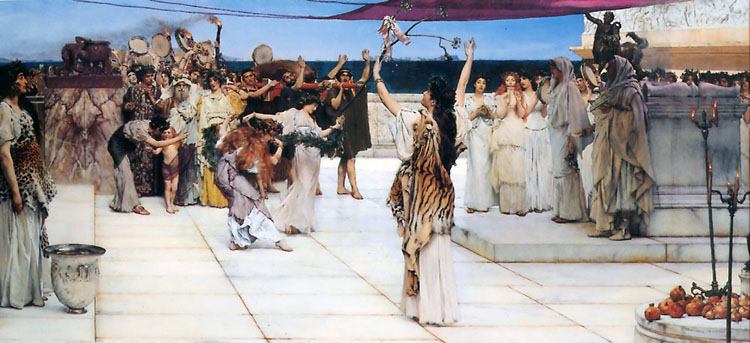
The golden haired child stands to the left of the painting, in front of a group of male and female musicians. Next to them is a pair of graceful female figures dancing to the music - these figures are meant to represent Bacchantes or Maeands, female followers of the god Bacchus. The center of the work is dominated by a tiger skin clad bacchante who is holding a branch in the air. She is echoed visually by another bacchante wearing a leopard skin who stands serenely on the far left.
While the actions of the beautifully depicted figures make A Dedication to Bacchus a compelling work, it is important to note that the rich archaeological details also contribute to the authenticity of this painting. Lawrence Alma-Tadema included several references to Classical art in this piece, such as his frieze of a Centauromachy (a mythological battle between the Lapiths and centaurs) that was based on an image from the Temple of Apollo at Bassae.
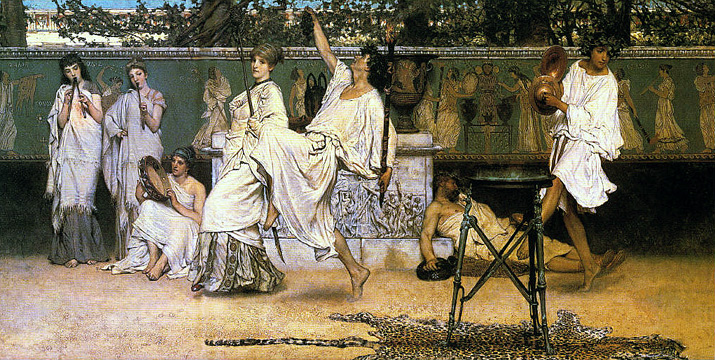
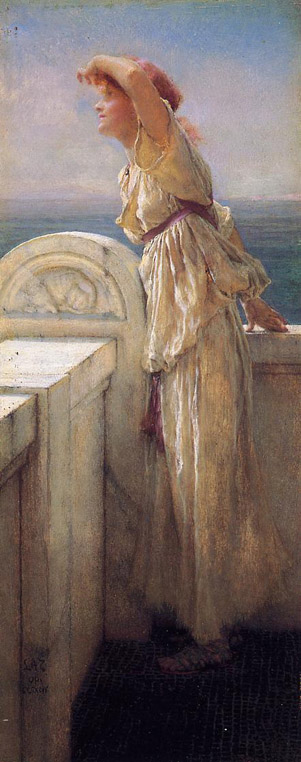
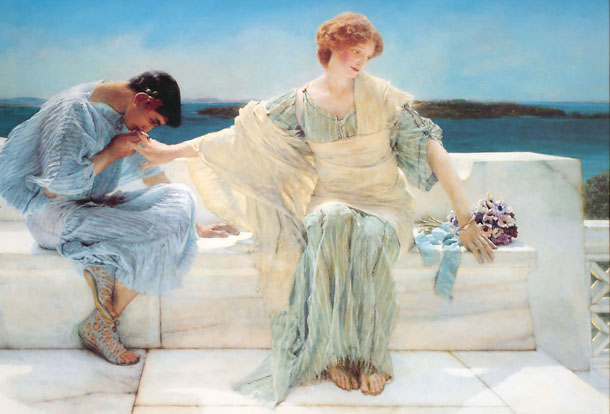
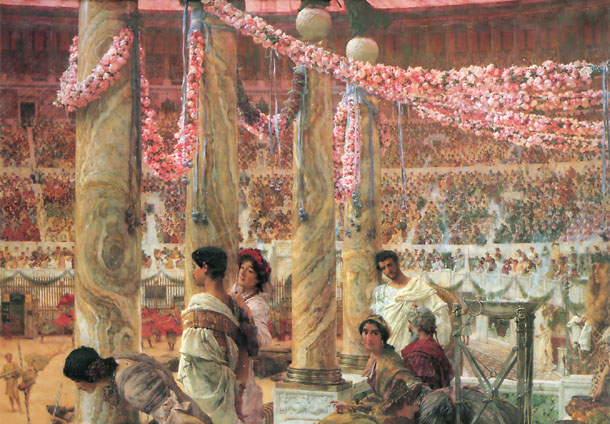
This promotion was unable to hide the family's dysfunctional relationships, especially the bitter rivalry developing between the two teenage brothers, Caracalla and Geta. Severus then, decided to take his sons with him on a campaign to Britain, first to get them out of Rome and second to keep his sons busy. While Caracalla commanded the troops his younger brother Geta was given civilian authority in Britain. Then more than a decade after his brother received the title Augustus Geta was also given this title, which meant that Geta theoretically was co-emperor along with Severus and Caracalla. Geta's increase in authority did though little to improve his relationship with Caracalla.
Soon after Geta received the title "Augustus" his father Severus' health began to deteriorate, and desperate pleas were made for his sons to get along. Severus died 4 February 211 in York. At the death of Severus Caracalla was 22 years old and his brother Geta 21. The Roman Empire now faced a similar situation than 50 years earlier between Marcus Aurelius and Lucius Verus as they too officially shared the empire. Caracalla might well have been satisfied with this situation had Geta behaved like Verus, whose authority was more official than real and who deferred to his older sibling in political matters. Geta, however, saw his authority as being truly equal to that of his brother, and the two were barely on speaking terms during the long trip back to Rome. Once in the city, the situation did not improve. Government ground to a halt as the two bickered about appointments and policy decisions. A later story even claimed the brothers were considering dividing the empire into two.
Known as an angry, impatient character, he perhaps simply lost patience. On the other hand, Geta was the more literate of the two, often surrounded by writers and intellects. It is therefore quite likely that Geta was making more of an impact with senators than his tempestuous brother. Perhaps even more dangerous to Caracalla, Geta was showing a striking facial similarity to his father Severus. Had Severus been very popular with the military, Geta's star might have been on the rise with them, as the generals believed to detect their old commander in him. Hence one could speculate that perhaps Caracalla opted to murder his brother, once he feared Geta might prove the stronger of the two of them.
By the end of the year Caracalla was being advised to have Geta murdered, and after at least one unsuccessful attempt at the start of the Saturnalia festival, Geta was killed in late December 211. Caracalla pretended to seek to reconcile with his brother and so suggested a meeting in the apartment of Julia Domna. Then as Geta arrived unarmed and unguarded, several centurions of Caracalla's guard broke through the door and cut him down. Geta died in his mother's arms.
Caracalla claimed that the murder came in response to Geta's plottings. His brother's death started a bloody and violent purge of Caracalla's suspected enemies. Geta's memory was condemned, his name was removed from inscriptions and his face removed from sculptures and paintings. Caracalla's critics looked back wistfully at the murdered prince, who came to be described as a lamb devoured by his ferocious, lion-like brother. Official restoration of Geta's reputation came with the arrival of the emperor Elagabalus to Rome in 219, when Geta's remains were put into the Mausoleum of Hadrian to join those of his father and brother.
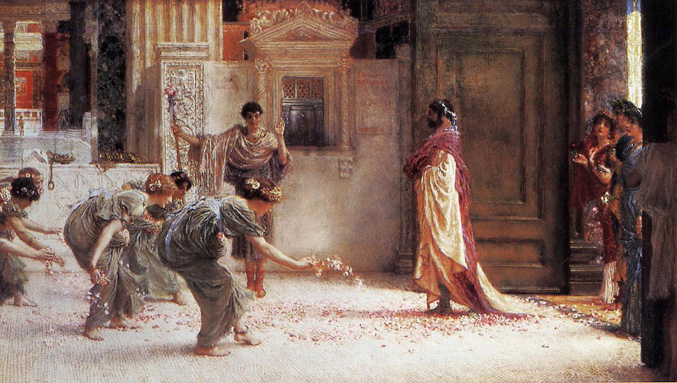
The nickname Caracalla was given to him, as he tended to wear a long Gallic cloak of that name.
In AD 195, his father, Emperor Septimius Severus, declared him Caesar, changing his name to Marcus Aurelius Antoninus. This announcement should spark off a bloody conflict between Severus and Clodius Albinus, the man who had been named Caesar previously.
With Albinus defeated at the battle of Lugdunum (Lyons) in February AD 197, Caracalla was made co-Augustus in AD 198. In AD 203-4 he visited his ancestral North Africa with his father and brother. Then in AD 205 he was consul alongside his younger brother Geta, with whom he lived in bitter rivalry.
From AD 205 to 207 Severus had his two quarrelsome sons live together in Campania, in his own presence, in order to try and heal the rift between them. However the attempt clearly failed.
In AD 208 Caracalla and Geta left for Britain with their father, to campaign in Caledonia. With his father ill, much of the command lay with Caracalla. When on campaign Caracalla was said to have been eager to have seen the end of his sick father. There is even a story of him trying to stab Severus in the back while the two were riding ahead of the troops. This however seems very unlikely. Knowing Severus' character, Caracalla would not have survived such failure.
However, a blow was dealt to Caracalla's aspirations when in AD 209 Severus did also raise Geta to the rank of Augustus. Evidently their father intended them to rule the empire together.
Septimius Severus died in February AD 211 at Eburacum (York). On his deathbed he famously advised his two sons to get on with each other and to pay the soldiers well, and not to care about anyone else. The brothers though should have a problem following the first point of that advice.
Caracalla was 23, Geta 22, when their father died. And felt such hostility towards each other, that it bordered on outright hatred.
Immediately after Severus' death there appeared to have been an attempt by Caracalla to seize power for himself. If this was truly an attempted coup is unclear. Far more it appears Caracalla tried to secure power for himself, by outright ignoring his co-emperor.
He conducted the resolution of the unfinished conquest of Caledonia by himself. He dismissed many of Severus' advisors who would have sought to also support Geta, following Severus' wishes.
Such initial attempts at ruling alone were clearly meant to signify that Caracalla ruled, whereas Geta was emperor purely by name (a little like emperors Marcus Aurelius and Verus had done earlier).
Geta however would not accept such attempts. Neither would his mother Julia Domna. And it was her who forced Caracalla to accept joint rule.
With the Caledonian campaign at an end the two then headed back for Rome with the ashes of their father. The voyage back home is noteworthy, as neither would even sit at the same table with the other for fear of poisoning.
Back in the capital, they tried to live alongside each other in the imperial palace. Yet so determined were they in their hostility, that they divided the palace in two halves with separate entrances. The doors which might have connected the two halves were blocked.
Each emperor surrounded himself with a large personal bodyguard.
Each brother sought to gain the favor of the senate. Either one sought to see his own favorite appointed to any official office which might become available. They also intervened in court cases in order to help their supporters. Even at the circus games, they publicly backed different factions. Worst of all attempts apparently were made from either side to poison the other.
Their bodyguards in a constant state of alert, both living in everlasting fear of being poisoned, Caracalla and Geta came to the conclusion that their only way of living as joint emperors was to divide the empire. Geta would take the east, establishing his capital at Antioch or Alexandria, and Caracalla would remain in Rome.
The scheme might have worked. But Julia Domna used her significant power to block it. It is possible that she feared, if they separated, she could no longer keep an eye on them. Most likely though she realized, that this proposal would lead to outright civil war between east and west.
Alas, in late December AD 211 he pretended to seek to reconcile with his brother and so suggested a meeting in the apartment of Julia Domna. Then as Geta arrived unarmed and unguarded, several centurions of Caracalla's guard broke through the door and cut him down. Geta died in his mother's arms.
What, other than hate, drove Caracalla to the murder is unknown. Known as an angry, impatient character, he perhaps simply lost patience. On the other hand, Geta was the more literate of the two, often surrounded by writers and intellects. It is therefore well likely that Geta was making more of an impact with senators than his tempestuous brother. Perhaps even more dangerous to Caracalla, Geta was showing a striking facial similarity to his father Severus. Had Severus been very popular with the military, Geta's star might have been on the rise with them, as the generals believed to detect their old commander in him.
Hence one could speculate that perhaps Caracalla opted to murder his brother, once he feared Geta might prove the stronger of the two of them.
Many of the praetorians didn't feel at all comfortable with the murder of Geta. For they remembered that they had sworn allegiance to both emperors. Caracalla though knew how to win their favor. He paid each man a bonus of 2'500 denarii, and raised their ration allowance by 50%. If this won over the praetorians then, a pay rise from 500 denarii to 675 (or 750) denarii to the legions assured him of their loyalty.
Further to this Caracalla then began hunting down any supporters of Geta. Up to 20'000 are believed to have died in this bloody purge. Friends of Geta, senators, equestrians, a praetorian prefect, leaders of the security services, servants, provincial governors, officers, ordinary soldiers - even charioteers of the faction Geta had supported; all fell victim to Caracalla's vengeance.
Suspicious of the military, Caracalla also now rearranged the way legions were based in the provinces, so that no single province would be host to more than two legions. Clearly this made revolt by provincial governors much more difficult.
However harsh, Caracalla's reign should not only be known for its cruelty. He reformed the monetary system and was an able judge when hearing court cases. But first and foremost of his acts is one of the most famous edicts of antiquity, the Constitutio Antoniniana. By this law, issued in AD 212, everyone in the empire, with the exception of slaves, was granted Roman citizenship.
Then in AD 213 Caracalla went north to the Rhine to deal with the Alemanni who were once more causing trouble in the Agri Decumates, the territory covering the springs of the Danube and Rhine. It was here that the emperor showed a remarkable touch in winning the sympathy of the soldiers. Naturally his pay rises had made him popular. But when with the troops, he marched on foot among the ordinary soldiers, ate the same food and even ground his own flour with them.
The campaign against the Alemanni was only a limited success. Caracalla defeated them in battle near the river Rhine, but failed to win a decisive victory over them. And so he chose to change tactics and instead sued for peace, promising to pay the barbarians an annual subsidy.
Other emperors would have paid dearly for such a settlement. To buy the opponent off was largely seen to be a humiliation for the troops. (Emperor Alexander Severus was killed by mutinous troops in AD 235 for the same reason.) But it was Caracalla's popularity with the soldier's which allowed him to get away with it.
In AD 214 Caracalla then headed east, through Dacia and Thrace to Asia Minor (Turkey). It was at this point that the emperor began to have delusions of being Alexander the Great. Gathering an army as he passed through the military provinces along the Danube, he reached Asia Minor at the head of a large army. One part of this army was a phalanx consisting of 16'000 men, in armor of the style of Alexander's Macedonian solders. The force was also accompanied by many war elephants. Statues of Alexander were ordered to be sent back home to Rome. Pictures were commissioned, which bore a face which was half Caracalla, half Alexander. Because Caracalla believed that Aristotle had had some part in Alexander's death, Aristotelian philosophers were persecuted.
The winter of AD 214/215 was passed at Nicomedia. In May AD 215 the force reached Antioch in Syria. Most likely leaving his great army behind at Antioch, Caracalla now went on to Alexandria to visit the tomb of Alexander.
It is not known what precisely occurred next in Alexandria, but somehow Caracalla grew enraged. He set the troops which were with him on the people of the city and thousands were massacred in the streets.
After this gruesome episode in Alexandria, Caracalla headed back to Antioch, where in AD 216 no fewer than eight legions were waiting for him. With these he now attacked Parthia, which was preoccupied with a bloody civil war. The frontiers of the province of Mesopotamia were pushed further east. Attempts though to overrun Armenia failed. Instead Roman troops marauded across the Tigris into Media and then finally withdrew to Edessa to spend the winter there.
Parthia was weak and had little with which it could respond to these attacks. Caracalla sensed his chance and planned further expeditions for the next year, most likely hoping to make some permanent acquisitions to the empire. Though it was not to be. The emperor might have enjoyed popularity with the army, but the rest of the empire still hated him.
It was Julius Martialis, an officer in the imperial bodyguard, who murdered the emperor on a voyage between Edessa and Carrhae, when he relieved himself out of sight from the other guards. Martialis himself was killed by the emperor's mounted bodyguard. But the mastermind behind the murder was the commander of the praetorian guard, Marcus Opelius Macrinus, the future emperor.
Caracalla was only 29 at his death. His ashes were sent back to Rome where they were laid to rest in the Mausoleum of Hadrian. He was deified in AD 218.
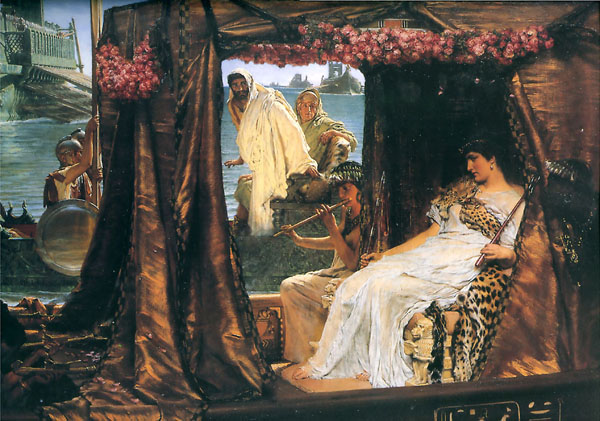
The seed that spawned their relationship was sown with the murder of Julius Caesar in March 44 BC. Rome descended into anarchy and civil war. By 41 BC Antony and Octavian (who would later change his name to Augustus) shared the leadership of Rome and had divided the state into two regions - the western portion including Spain and Gaul ruled by Octavian, the eastern region including Greece and the Middle East ruled by Antony.
The Parthian Empire located in modern-day Iraq posed a threat to Antony's eastern territory and he planned a military campaign to subdue them. But Antony needed money to put his plan into action and he looked to Cleopatra - ruler of Egypt and the richest woman in the world - to supply it. In 41 BC he summoned Cleopatra to meet him in the city of Tarsus in modern-day Turkey.
Cleopatra was a seductive woman and she used her talents to maintain and expand her power. Her first conquest was Julius Caesar in 48 BC. He was 52, she was 22. Their relationship produced a son and was ended only by Caesar's assassination.
Her initial response to Antony's summons was to delay her journey - possibly to send the message to the Roman leader that as a queen in her own right, she was not at his beck and call. Eventually surrendering to the inevitable, Cleopatra sailed from Egypt to the city of Tarsus. As she made the final leg of her journey up the river Cydnus she traveled in a magnificent barge filled with flowers and scented with exotic perfumes while she reclined on deck surrounded by her servants and trappings of gold. Antony enjoyed women and once he saw her, he fell under her spell.
(Antony was) "...carried away by her to Alexandria, there to keep holiday, like a boy, in play and diversion, squandering and fooling away in enjoyment that most costly of all valuables, time."
Plutarch was a Greek historian who wrote a history of the Life of Antony in the first century AD. We join his story as Cleopatra receives Antony's summons to join him:
"She had faith in her own attractions, which, having formerly recommended her to Caesar and the young Pompey, she did not doubt might prove yet more successful with Antony. Their acquaintance was with her when a girl, young, and ignorant of the world, but she was to meet Antony in the time of life when women's beauty is most splendid, and their intellects are in full maturity. She made great preparations for her journey, of money, gifts, and ornaments of value, such as so wealthy a kingdom might afford, but she brought with her surest hopes in her own magic arts and charms.
...she came sailing up the river Cydnus in a barge with gilded stern and outspread sails of purple, while oars of silver beat time to the music of flutes and fifes and harps. She herself lay all along, under a canopy of cloth of gold, dressed as Venus in a picture, and beautiful young boys, like painted Cupids, stood on each side to fan her. Her maids were dressed like Sea Nymphs and Graces, some steering at the rudder, some working at the ropes.
...perfumes diffused themselves from the vessel to the shore, which was covered with multitudes, part following the galley up the river on either bank, part running out of the city to see the sight. The market place was quite emptied, and Antony at last was left alone sitting upon the tribunal; while the word went .through all the multitude, that Venus was come to feast with Bacchus for the common good of Asia.
On her arrival, Antony sent to invite her to supper. She thought it fitter he should come to her; so, willing to show his good humor and courtesy, he complied, and went. He found the preparations to receive him magnificent beyond expression, but nothing so admirable as the great number of lights; for on a sudden there was let down altogether so great a number of branches with lights in them so ingeniously disposed, some in squares, and some in circles, that the whole thing was a spectacle that has seldom been equaled for beauty.
The next day, Antony invited her to supper, and was very desirous to outdo her as well in magnificence as contrivance; but he found he was altogether beaten in both, and was so well convinced of it, that he was himself the first to jest and mock at his poverty of wit, and his rustic awkwardness. She, perceiving that his raillery was broad and gross, and savored more of the soldier than the courtier, rejoined in the same taste, and fell into it at once, without any sort of reluctance or reserve.
For her actual beauty, it is said, was not in itself so remarkable that none could be compared with her, or that no one could see her without being struck by it, but the contact of her presence, if you lived with her, was irresistible; the attraction of her person, joining with the charm of her conversation, and the character that attended all she said or did, was something bewitching. It was a pleasure merely to hear the sound of her voice, with which, like an instrument of many strings, she could pass from one language to another; so that there were few of the barbarian nations that she answered by an interpreter.
Antony was so captivated by her, that while Fulvia his wife maintained his quarrels in Rome against Caesar by actual force of arms, and the Parthian troops...were assembled in Mesopotamia, and ready to enter Syria, he could yet suffer himself to be carried away by her to Alexandria, there to keep holiday, like a boy, in play and diversion, squandering and fooling away in enjoyment that most costly, as Antiphon says, of all valuables, time.
Were Antony serious or disposed to mirth, she had at any moment some new delight or charm to meet his wishes; at every turn she was upon him, and let him escape her neither by day nor by night. She played at dice with him, drank with him, hunted with him; and when he exercised in arms, she was there to see.
At night she would go rambling with him to disturb and torment people at their doors and windows, dressed like a servant woman for Antony also went in servant's disguise, and from these expeditions he often came home very scurvily answered, and sometimes even beaten severely, though most people guessed who it was. However, the Alexandrians in general liked it all well enough, and joined good humouredly and kindly in his frolic and play, saying they were much obliged to Antony for acting his tragic parts at Rome, and keeping his comedy for them."
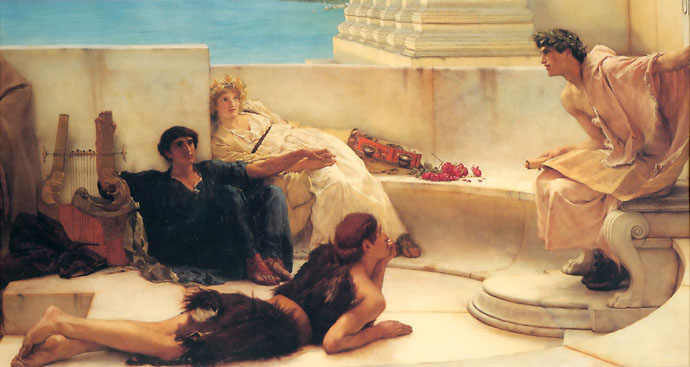
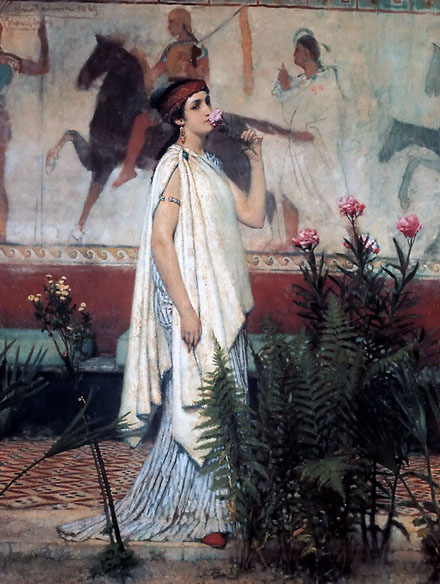
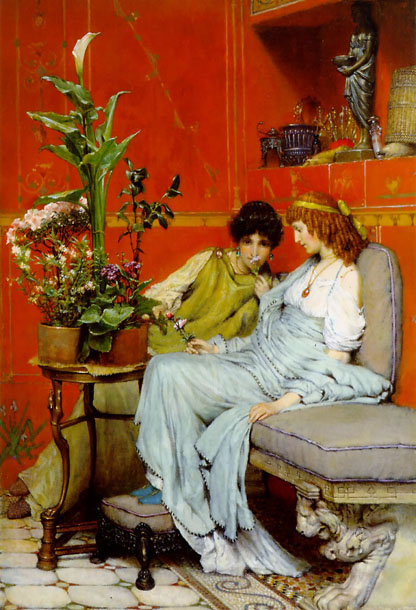
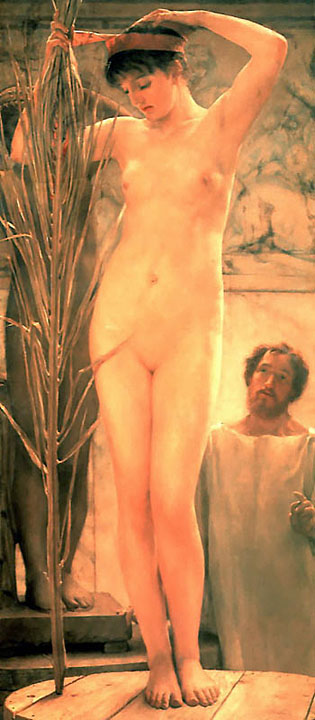
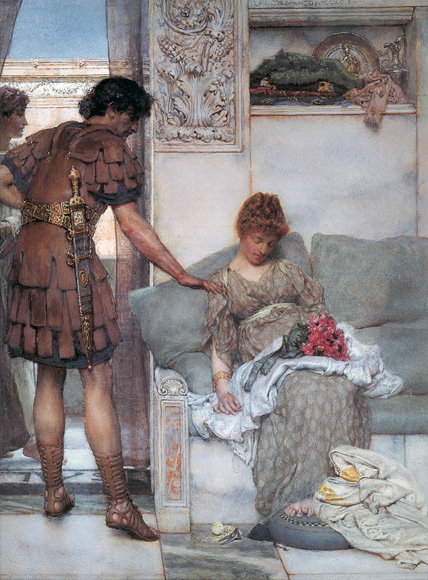
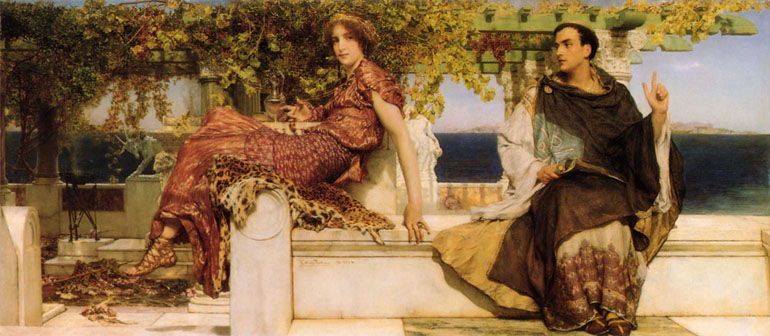
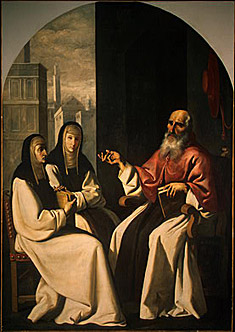
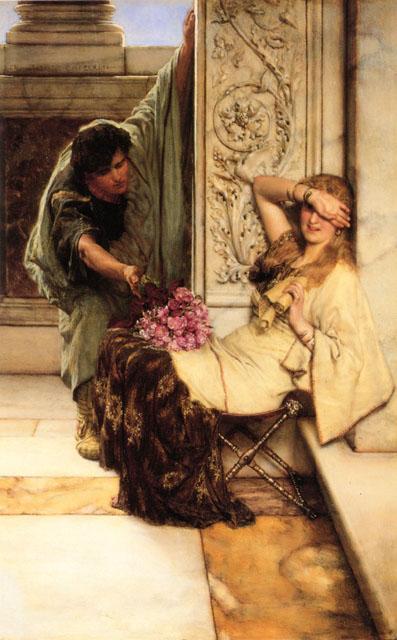
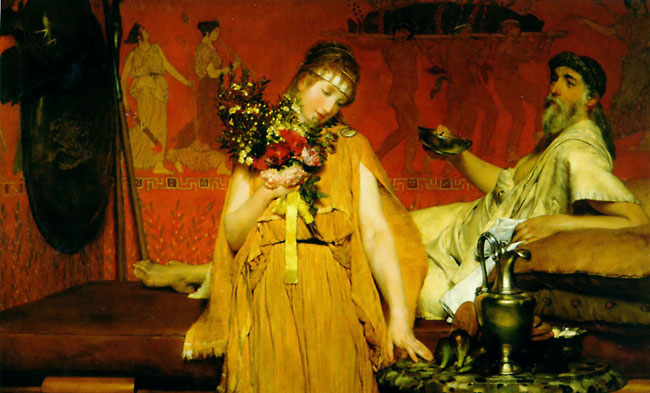
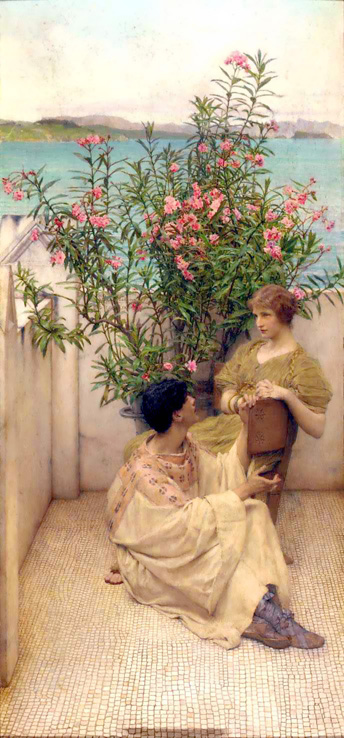
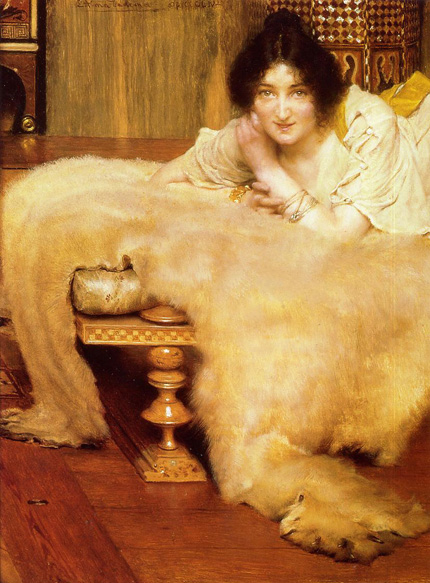
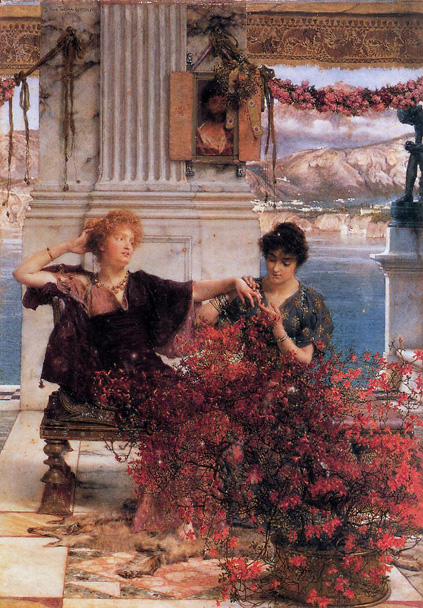
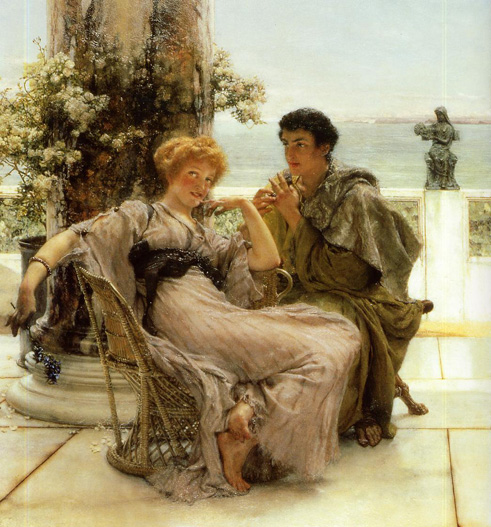
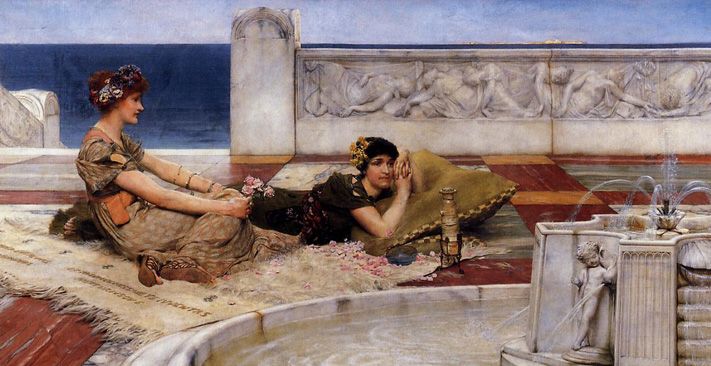
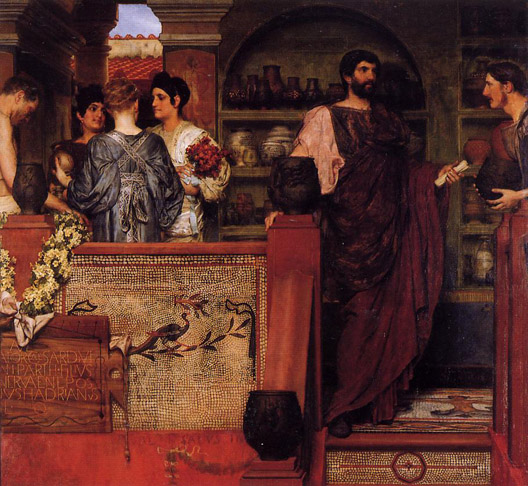
Upon the ascension of Trajan as emperor, Hadrians career began to advance. In 96 AD Hadrian held his first public office as a tribune of Macedonia. Following his Tribuneship ,Hadrian served in Trajan's Dacian wars between 101 AD and 106 AD. Also, Hadrian was made Quaestor by Trajan in 101 AD and later Quaestor in 106 AD. Hadrian was elected to his first consulship in 106 AD and later again in 118 AD. In 114 AD Hadrian was made governor of Syria where he became disliked due to the fact that he was accused of executing four senators which he denied by saying that the senate ordered the executions, not him.
Trajan died in 117 AD and Hadrian immediately succeeded to the throne as emperor. Immediately upon his ascension, Hadrian alienated the senate because of the way that they had handled a past conspiracy against him. In this conspiracy, four ex senators had plotted treason and were consequently executed by the time Hadrian became emperor. Hadrian denied those accusations but he was still relatively unpopular with the people and so set out to repair his reputation. Hadrian started by staging a Parthian Triumph that Trajan had won before his death and he also cut down on the taxes and held lavish gladiatorial games. As well, he continued the policies of helping the poor children of Rome, a policy which had been initiated by Nerva and continued by Trajan.
By ways of military conquests, not much happened during Hadrian's reign. Almost immediately upon becoming emperor, Hadrian returned most eastern lands that Trajan had conquered because he believed that the empire was too big for its borders to be successfully guarded. He believed that it was important to strengthen Rome's frontiers and to not conquer as much. To accomplish this he artifically defended, with walls and fortifications, the non natural boundaries of the empire and his most famous wall, known as Hadrian's Wall, was built in northern Britain to keep dangerous invaders out of the frontier province.
The most notable part of Hadrian's reign was his extensive tour of the whole empire. Hadrian spent most of his time as emperor in other parts of the empire, other than Italy. He traveled all the way from Greece to Britain and Africa. Hadrian was a deep lover of Greek architecture and so built great public buildings throughout the empire. The chief reason for Hadrian's visit of the empire, however, was for boundary security and army training and he made it a habit to march with the soldiers while travelling from place to place. Only one war was fought during his reign and it involved yet another Jewish Revolt in Judea which he quieted in 135 AD through use of force. He also made four new provinces which were later abolished.
Hadrian's homosexual relationship with the Greek youth Antonius is well known through history and remains one of the defining parts of his reign. It is said that, while the two were on a tour of Egypt, Antonius fell off of a barge in the Nile and died. The loss of his young lover made Hadrian go insane and he immediately deified the youth and had cults developed to worship him. Hadrian also named some cities throughout the empire after him.
With the death of Antonius, Hadrian was getting old and sick and so became a recluse whose final years were a reign of terror, with increased executions. During this time he spent most of his time in his grand country villa, the remains of which still stand today. After numerous failed attempts at a successor, Hadrian chose Antonius Pius to succeed him on the condition that he would adopt the young Marcus Aurelius and Lucius Aurelius Commodius Verus (Lucius Verus) as his successors.
Hadrian later died in the year 138 AD in his villa and was later deified upon the firm assistance of Antonius. Hadrian died an unpopular man with the senate and it was only with the intervention of Antonius, who was later given the title "Pius" for his merciful act towards the dead emperor. Hadrian was 60 when he died and had ruled Rome for over 20 years.
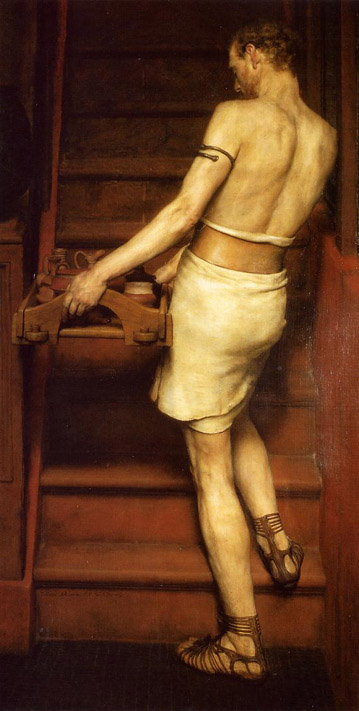
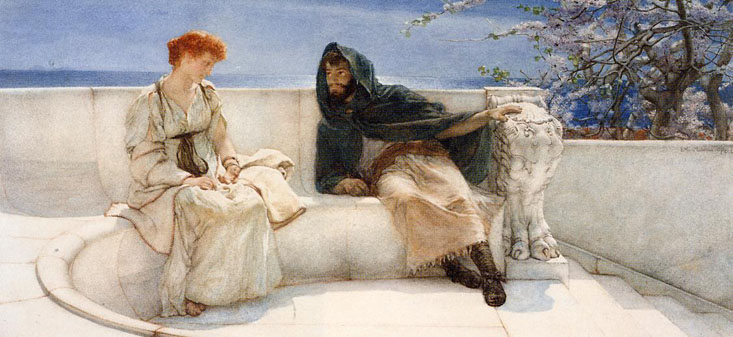
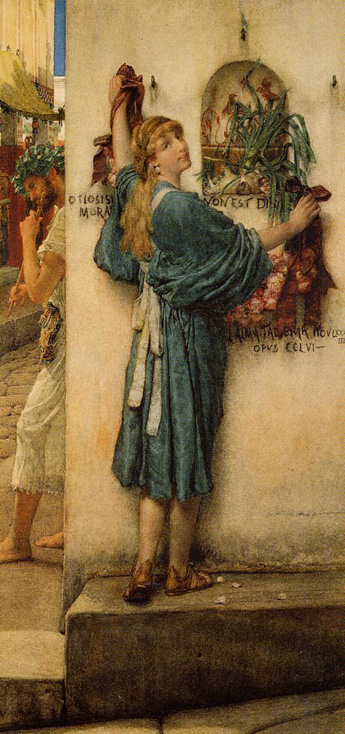
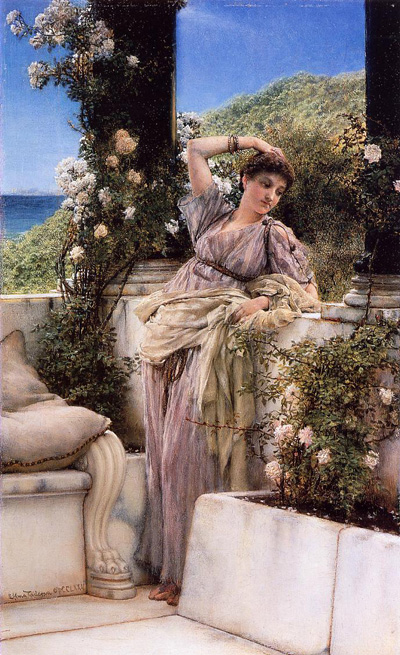
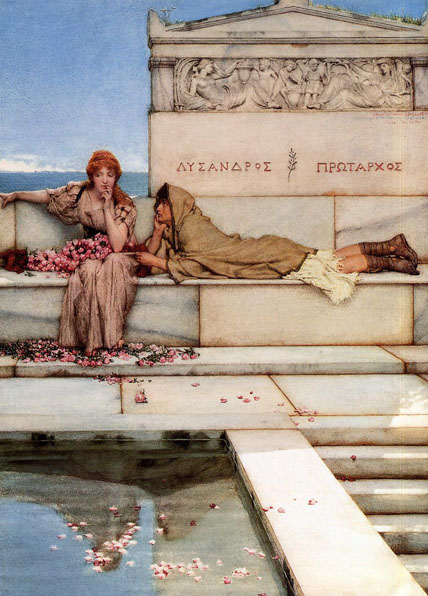
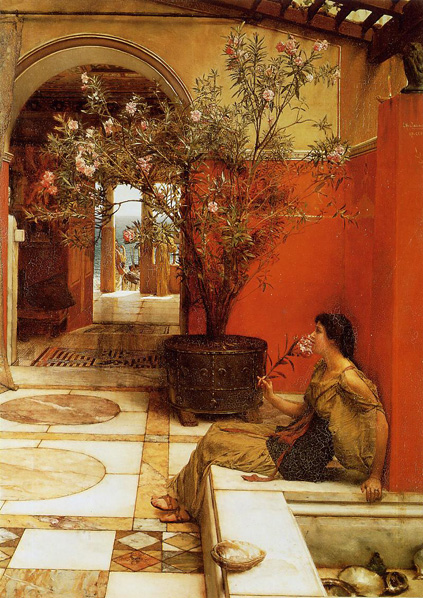
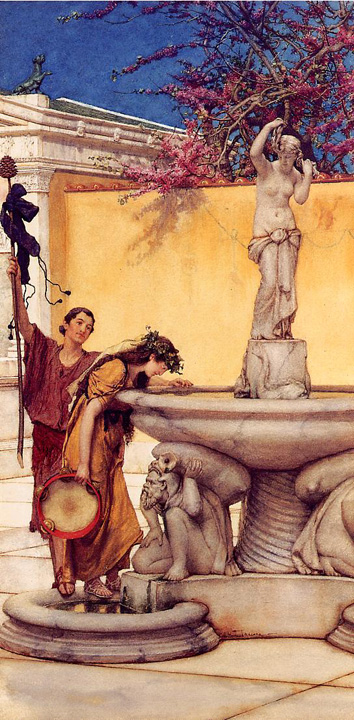
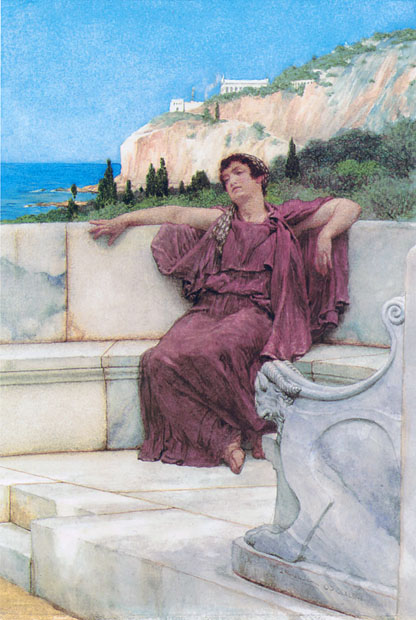
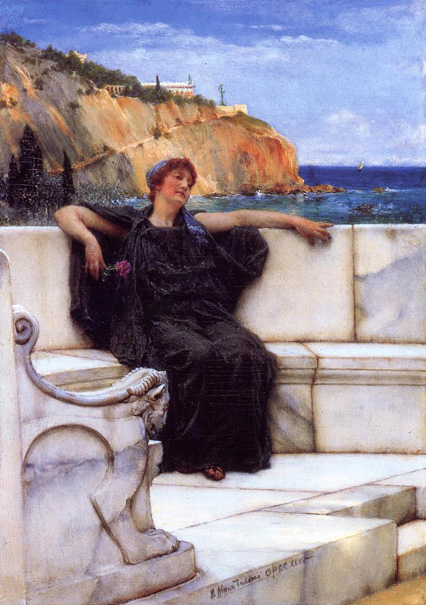
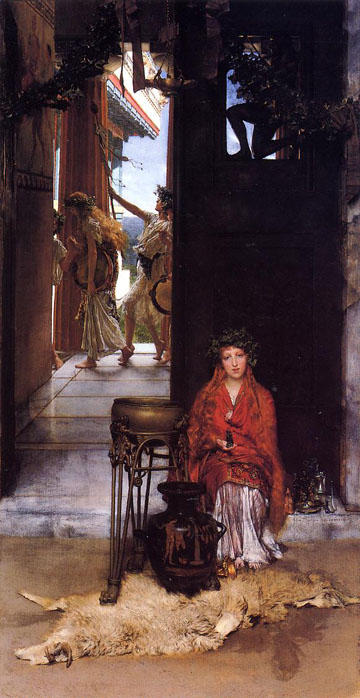
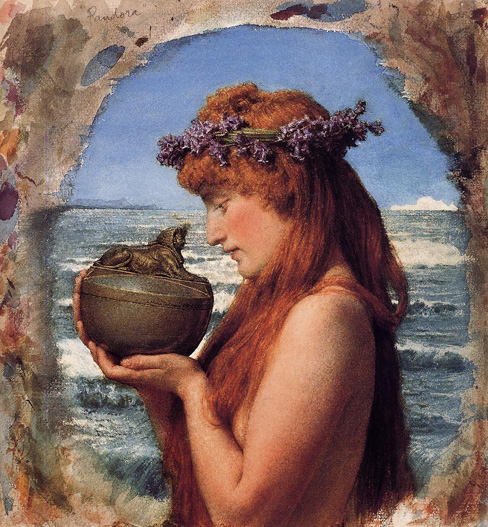
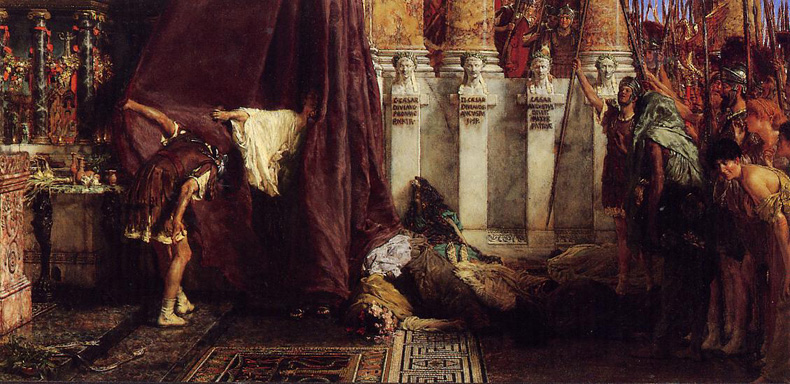
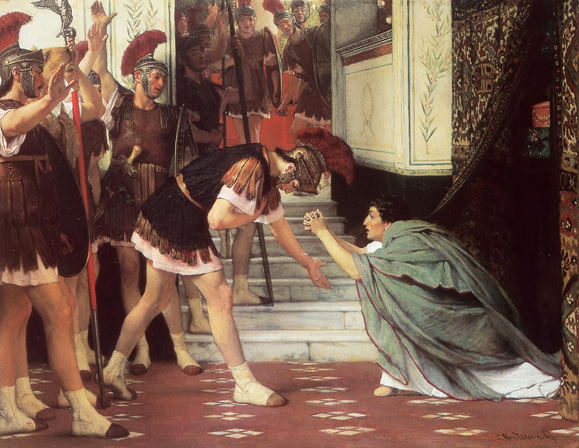
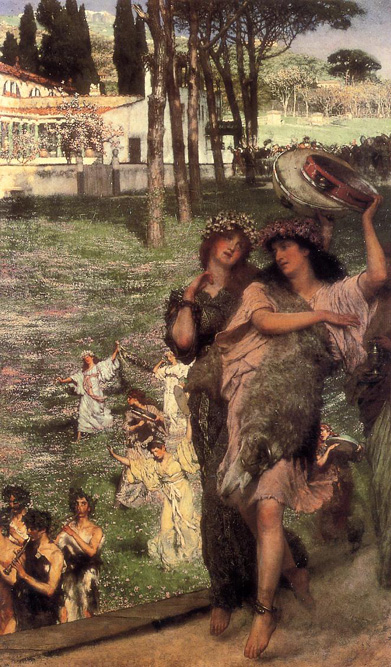
She was beloved for her service to mankind in giving them the gift of the harvest, the reward for cultivation of the soil. Also known as the Greek Goddess Demeter, Ceres was the goddess of the harvest and was credited with teaching humans how to grow, preserve, and prepare grain and corn. She was thought to be responsible for the fertility of the land.
Ceres was the only one of the gods who was involved on a day-to-day basis in the lives of the common folk. While others occasionally "dabbled" in human affairs when it suited their personal interests, or came to the aid of "special" mortals they favored, the goddess Ceres was truly the nurturer of mankind.
Ceres was worshipped at her temple on the Aventine Hill, one of the Seven Hills of ancient Rome. Her festival, the Cerealia, was celebrated on April 19. Another special time for Ceres was Ambarvalia, a Roman agricultural fertility rite held at the end of May. Ceres is portrayed holding a scepter or farming tool in one hand and a basket of flowers, fruits, or grain in the other. She may also be wearing a garland made from ears of corn.
The Romans explained the turning of the seasons with the following story: Ceres was the sister of Jupiter, and Proserpine was their daughter. Proserpine was kidnapped by Pluto, god of the underworld, to be his bride. By the time Ceres followed her daughter, she was gone into the earth. Making matters worse, Ceres learned that Pluto had been given Jupiter's approval to be the husband of his daughter. Ceres was so angry that she went to live in the world of men, disguised as an old woman, and stopped all the plants and crops from growing, causing a famine. Jupiter and the other gods tried to get her to change her mind but she was adamant. Jupiter eventually realized that he had to get Proserpine back from the underworld, and sent for her. Unfortunately, Pluto secretly gave her food before she left, and once one had eaten in the underworld one could not forever leave. Proserpine was therefore forced to return to the underworld for four months every year. She comes out in spring and spends the time until autumn with Ceres, but has to go back to the underworld in the winter. Her parting from Ceres every fall is why plants lose their leaves, seeds lie dormant under the ground, and nothing grows until spring when Proserpine is reunited with her mother.
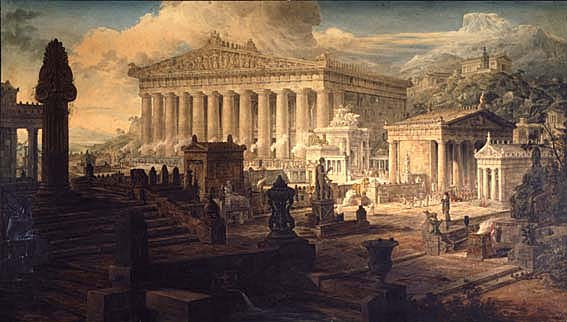
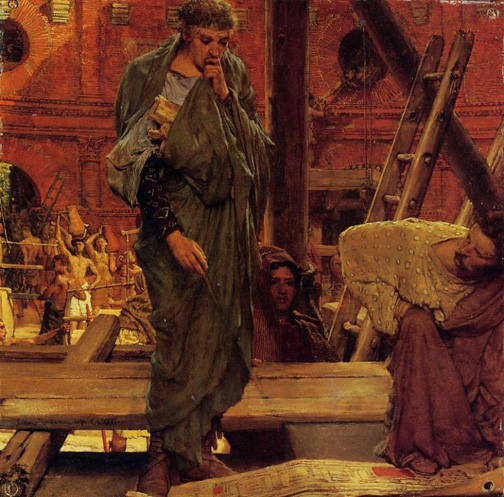
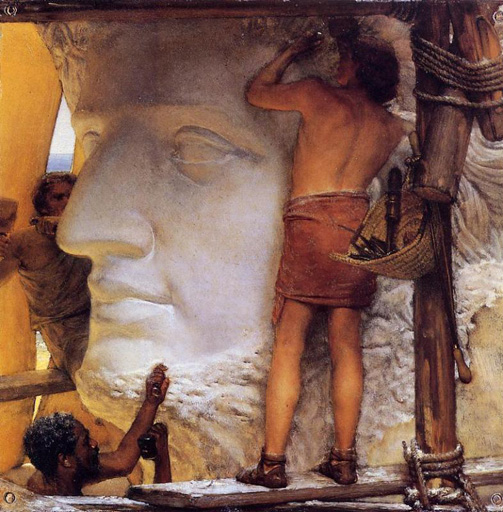
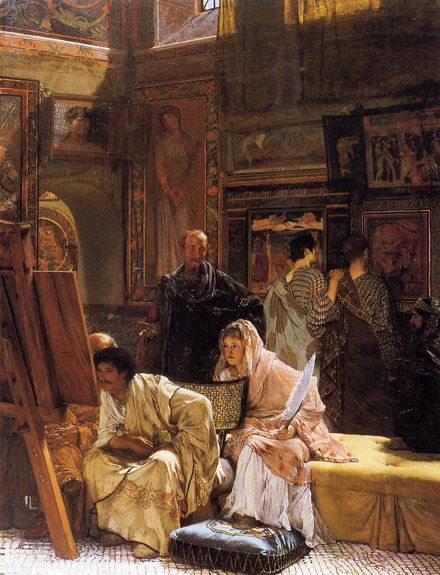
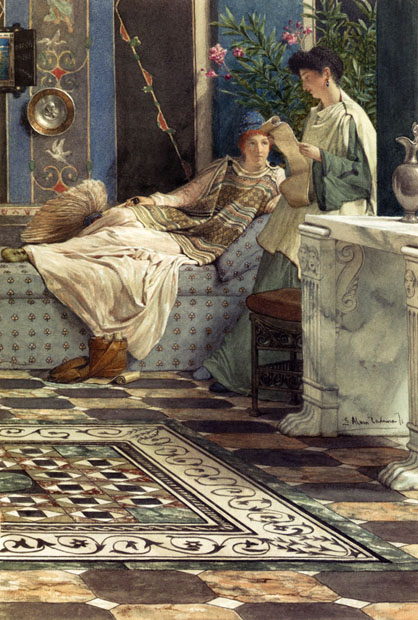
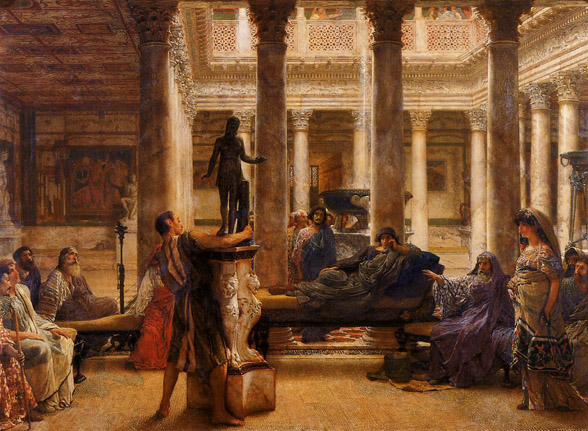
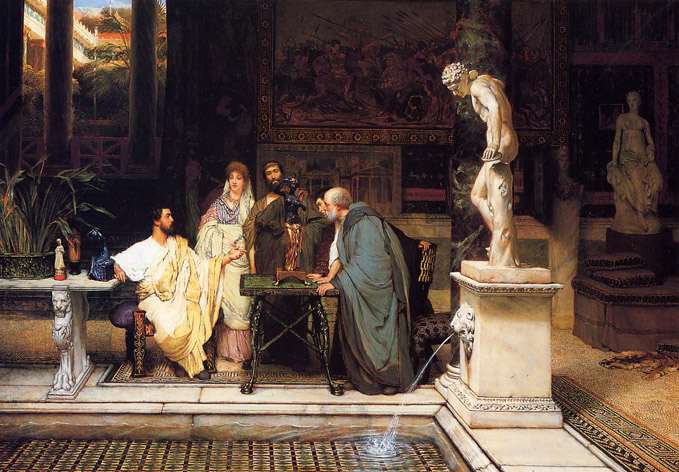
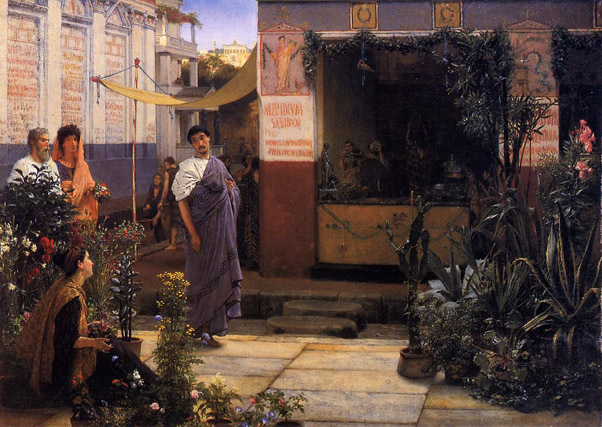
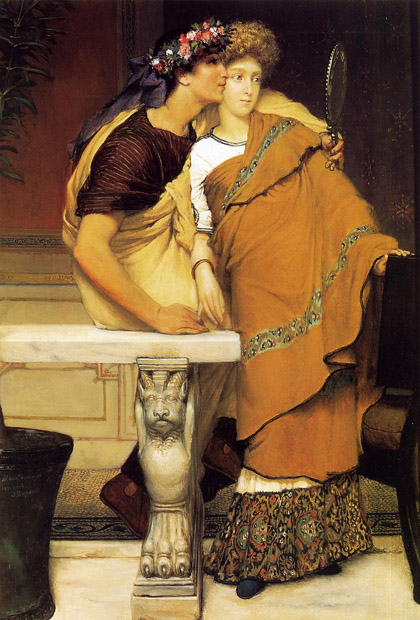
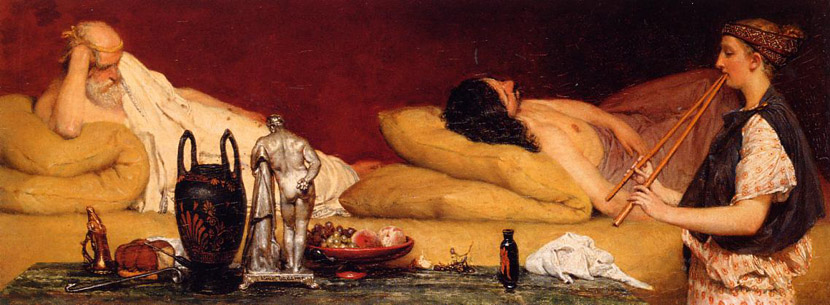
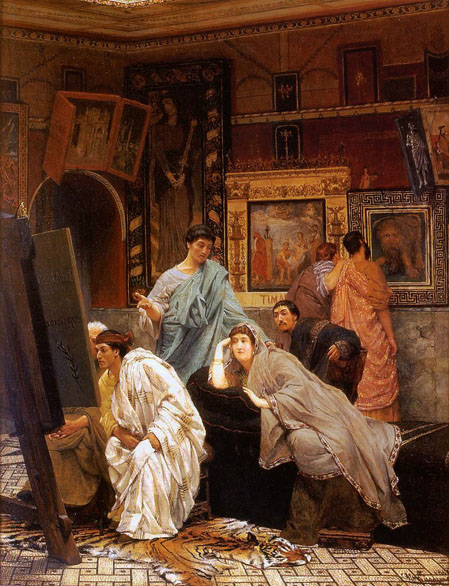
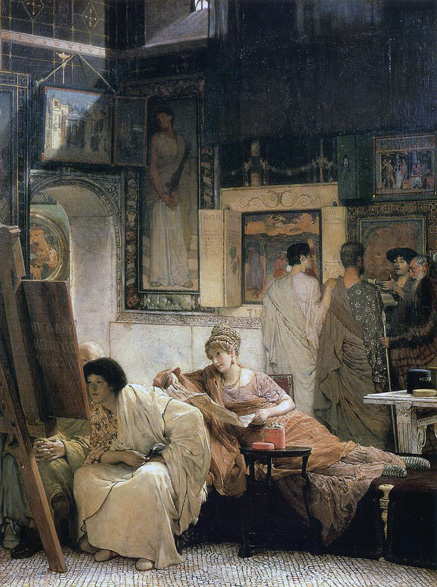
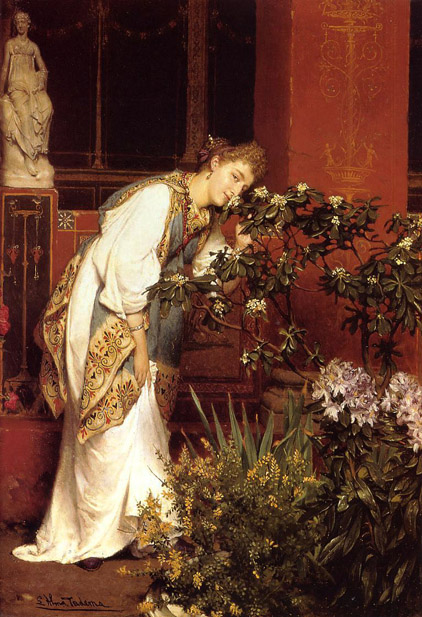
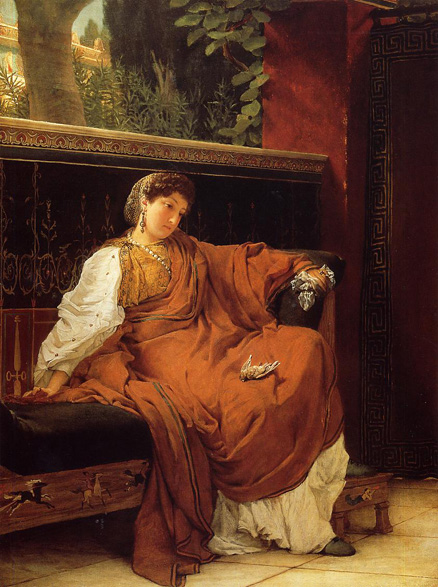
Sparrow, favorite of my girl,
with whom she is accustomed to play, whom she is accustomed to hold in her lap,
for whom, seeking greedily, she is accustomed to give her index finger
and to provoke sharp bites.
When it is pleasing for my shining desire
to make some kind of joke
and a relief of her grief.
I believe, so that her heavy passion may become quiet.
If only I were able to play with you yourself, and
to lighten the sad cares of your mind.
By Gaius Valerius Catullus
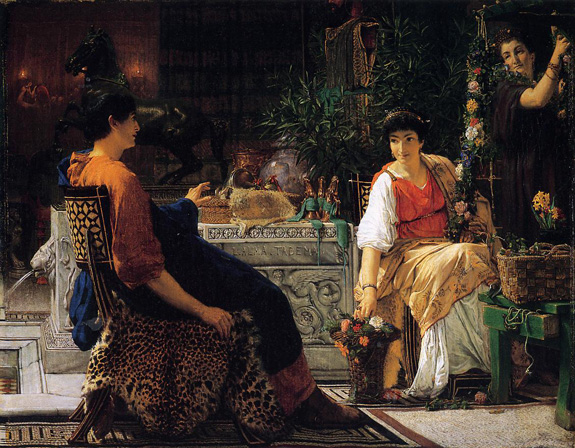
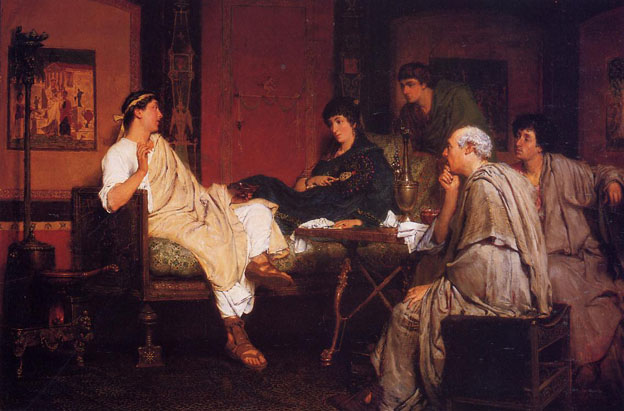
Tibullus's chief friend and patron was Marcus Valerius Messalla Corvinus, himself an orator and poet as well as a statesman and a commander. Messalla, like Gaius Maecenas, was at the center of a literary circle in Rome. This circle had no relationship with the court, and the name of Augustus is found nowhere in the writings of Tibullus. About 30 BC Messalla was dispatched by Augustus to Gaul to quell a rising in Aquitania and restore order in the country, and Tibullus may have been in his retinue. On a later occasion, probably in 28, he would have accompanied his friend who had been sent on a mission to the East, but he fell sick and had to stay behind in Corcyra. Tibullus had no liking for war, and though his life seems to have been divided between Rome and his country estate, his own preferences were wholly for the country life
. The loss of Tibullus's landed property is attested by himself, "Felicis quondam, nunc pauperis agri" ("Once fruitful, now impoverished fields". Its cause is only an inference, though a very probable one. That he was allowed to retain a portion of his estate with the family mansion is clear from his writing. Tibullus may have been Messalla's contubernalis in the Aquitanian War (Vita Tib. and Tib. i. 7, 9 seq., a poem composed for Messalla's triumph), and may have received militaria dona (Vita Tib.).
Tibullus died prematurely, probably in 19, and almost immediately after Virgil. His death made a deep impression in Rome, as we learn from his contemporary, Domitius Marsus, and from the elegy in which Ovid (Amores, iii. 19) enshrined the memory of his predecessor.
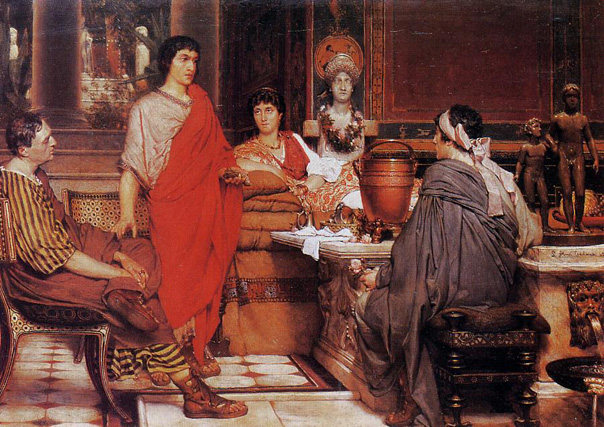
Let us live, my Lesbia, and let us love,
and let us judge all the rumors of the old men
to be worth just one penny!
The suns are able to fall and rise:
When that brief light has fallen for us,
we must sleep a never ending night.
Give me a thousand kisses, then another hundred,
then another thousand, then a second hundred,
then yet another thousand more, then another hundred.
Then, when we have made many thousands,
we will mix them all up so that we don't know,
and so that no one can be jealous of us when he finds out
how many kisses we have shared.
By Gaius Valerius Catullus
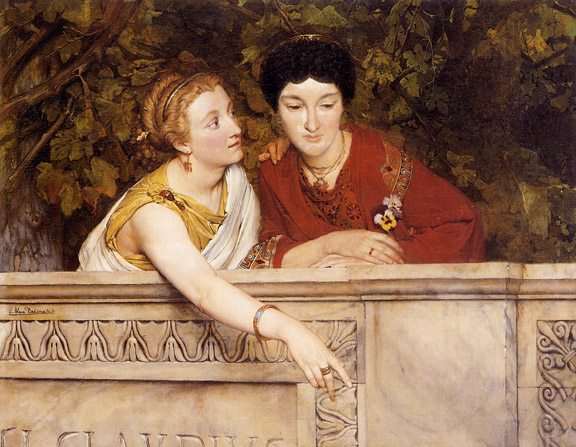
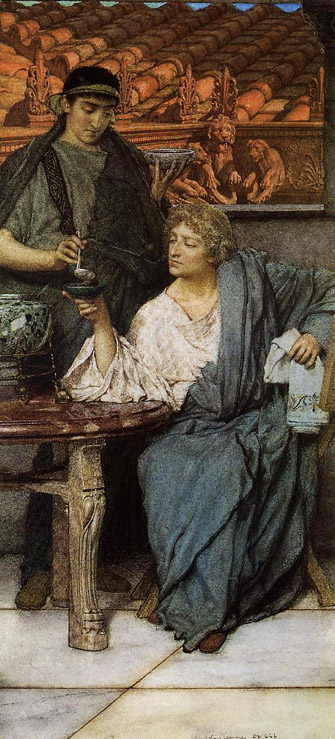
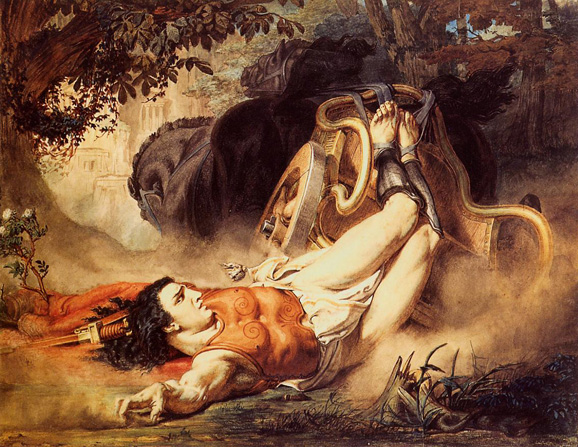
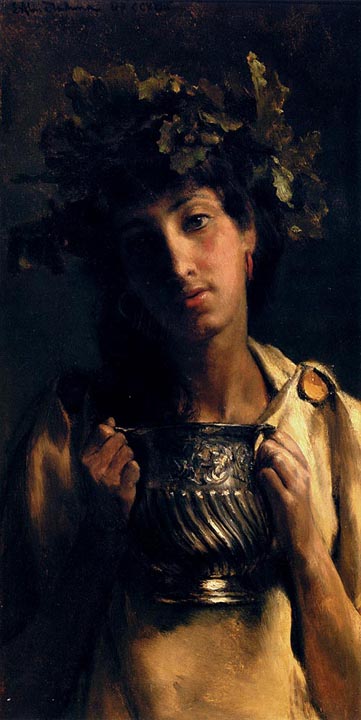
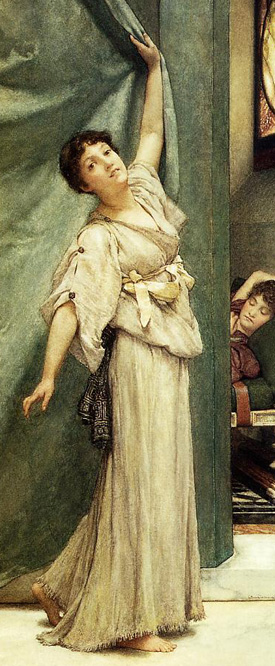
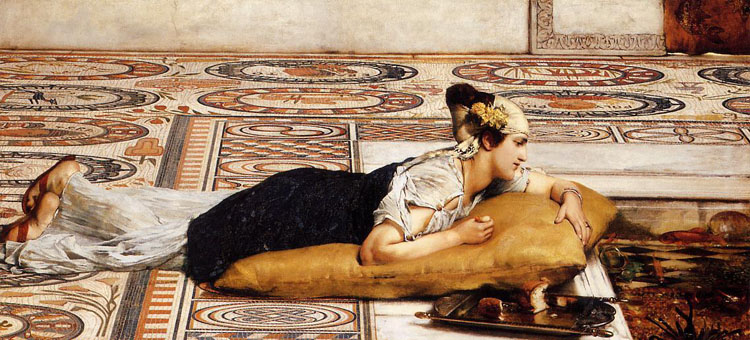
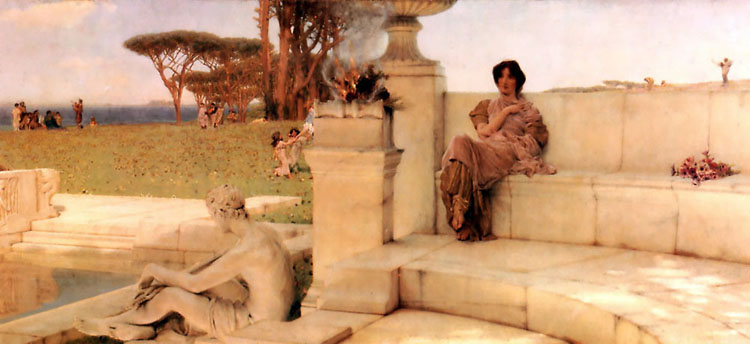
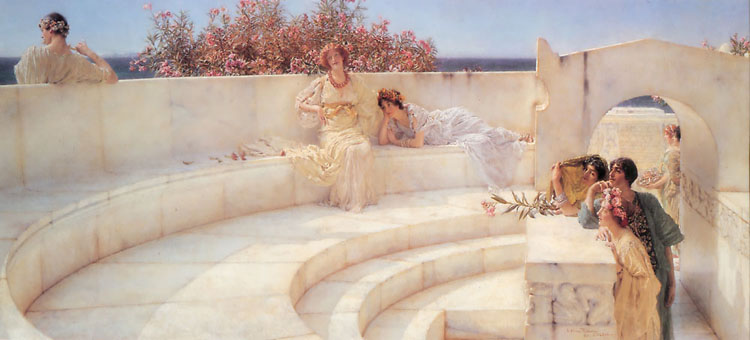
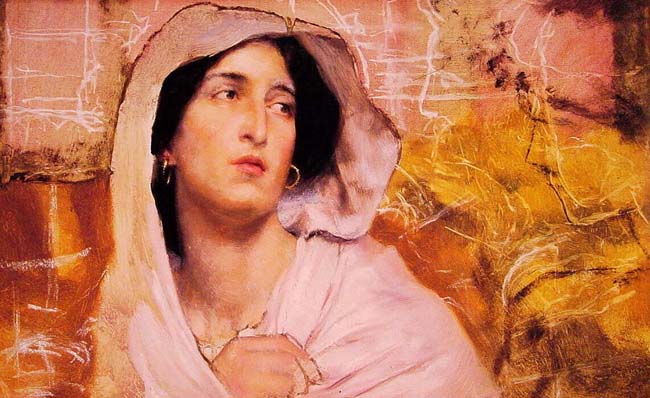
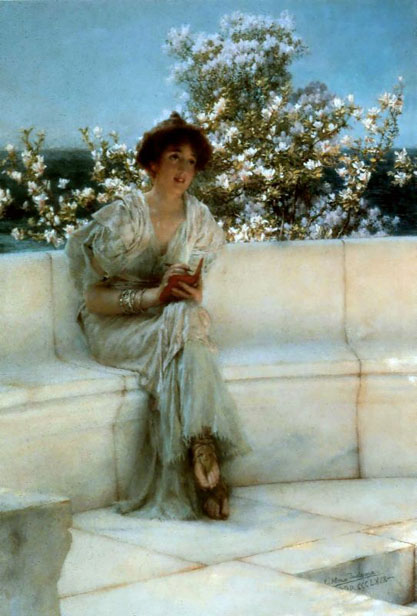
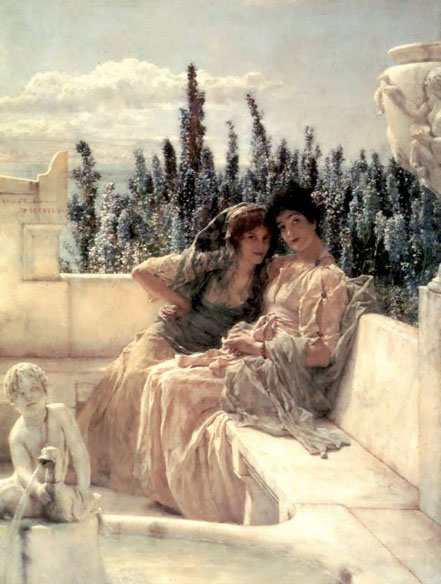
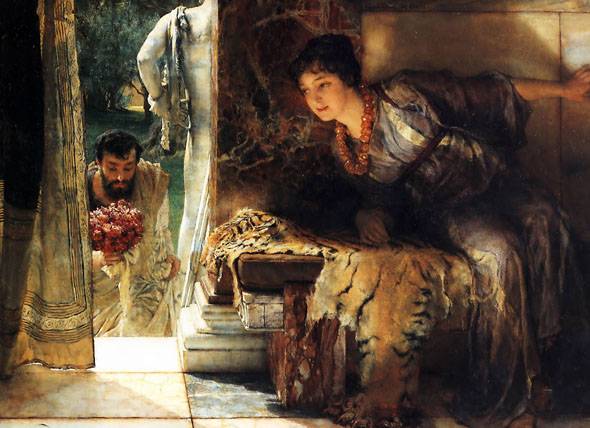
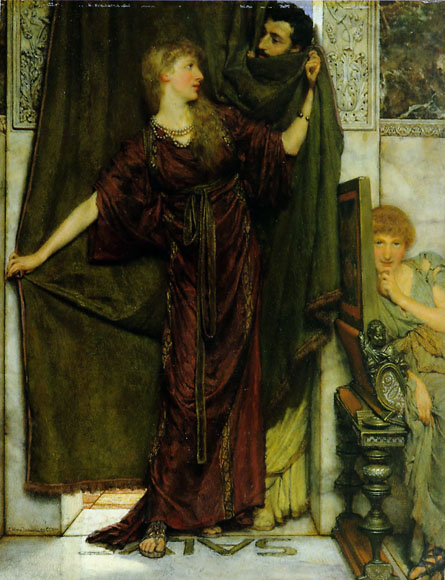

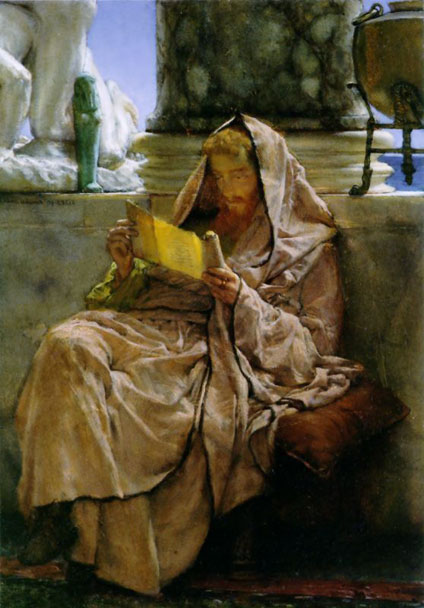
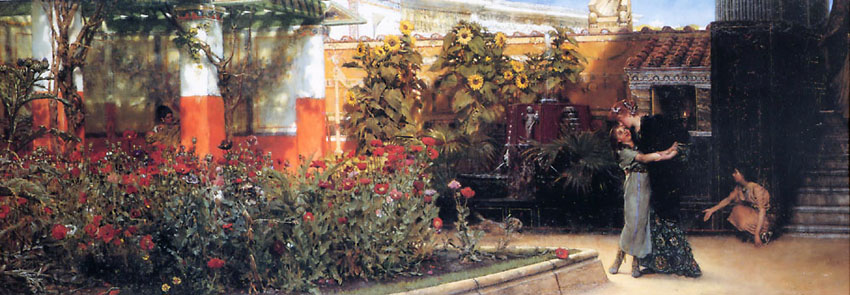
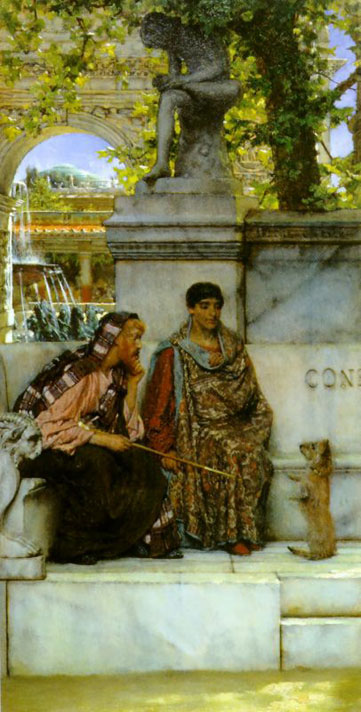
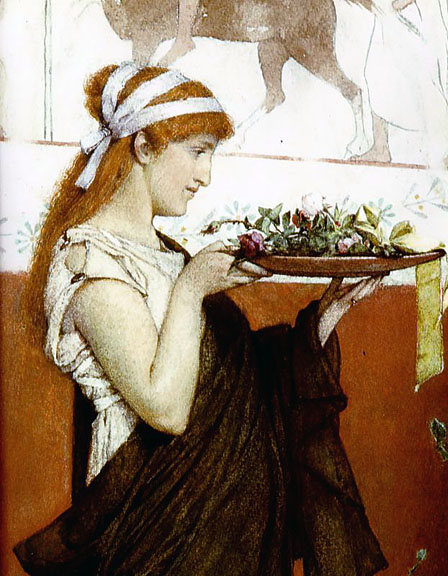
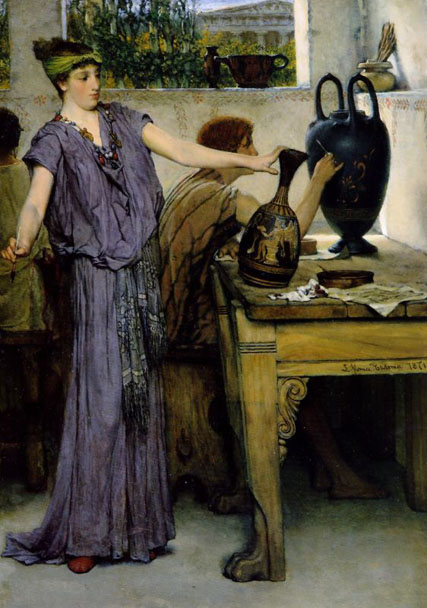
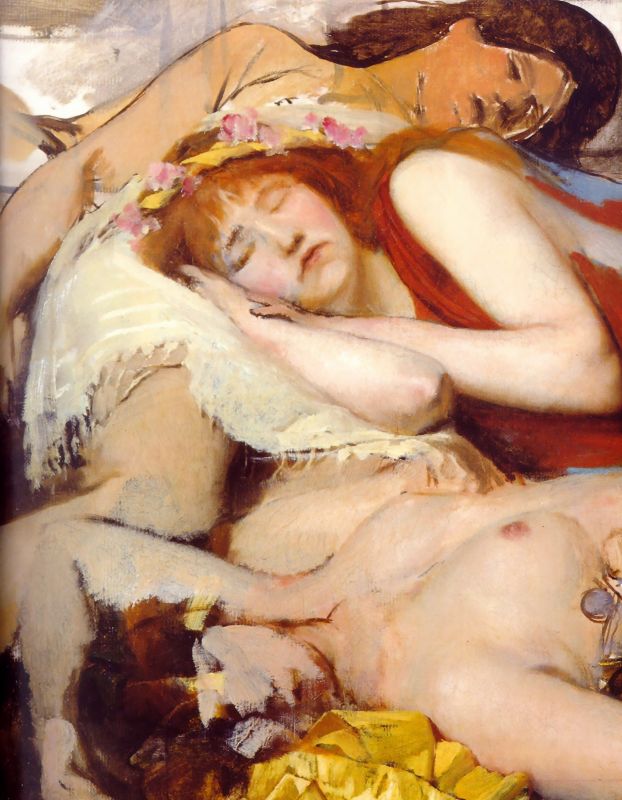
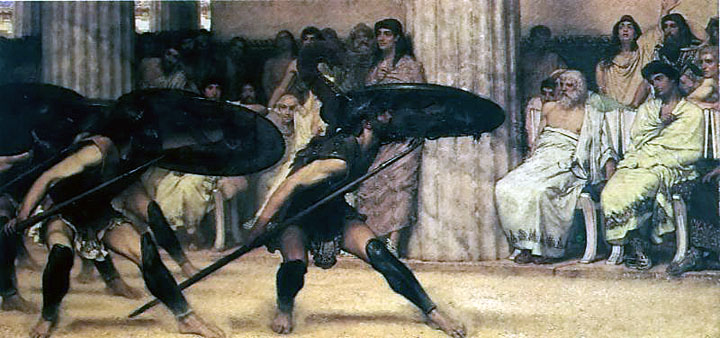
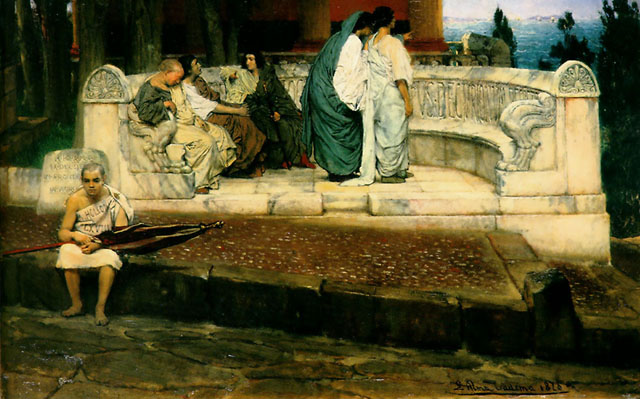

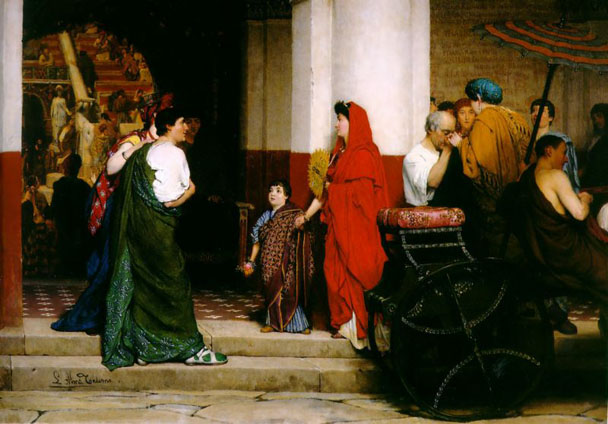
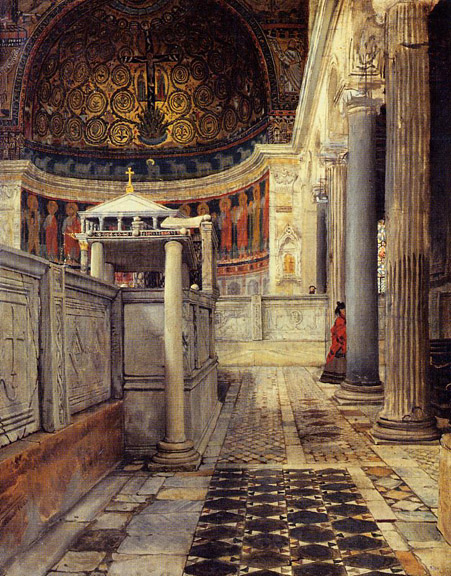
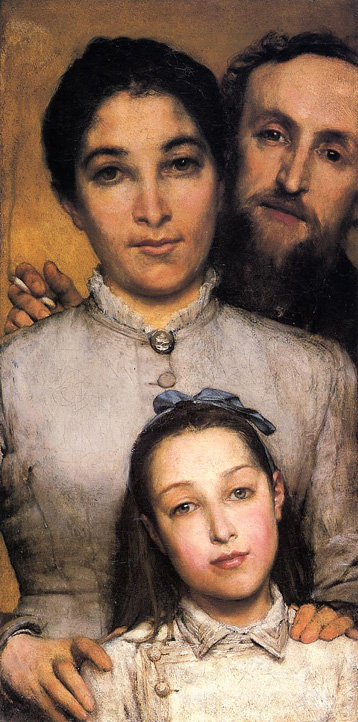
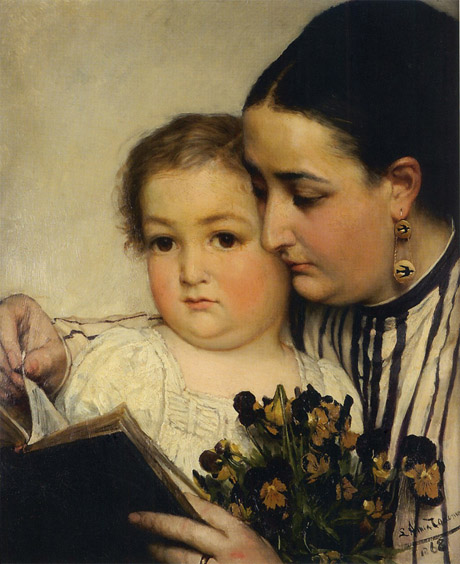
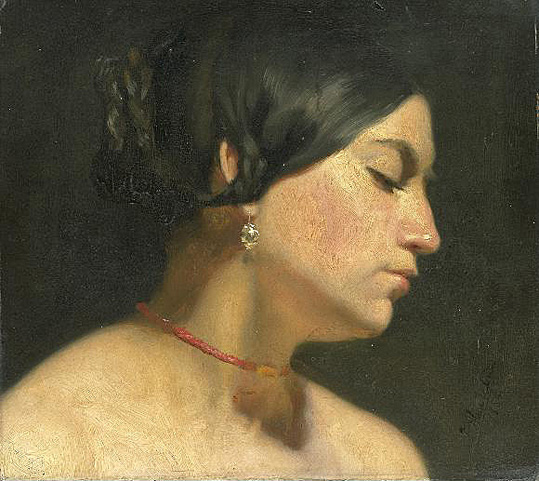

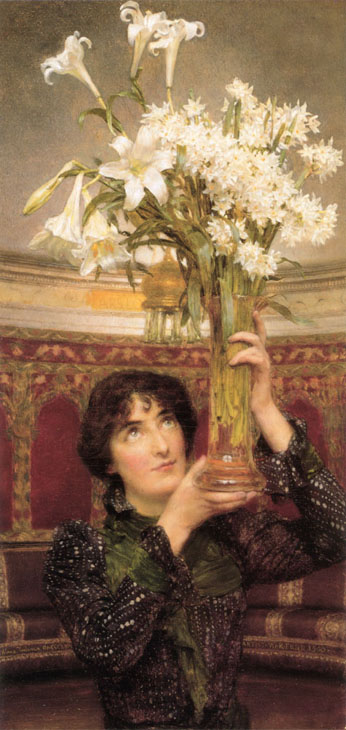
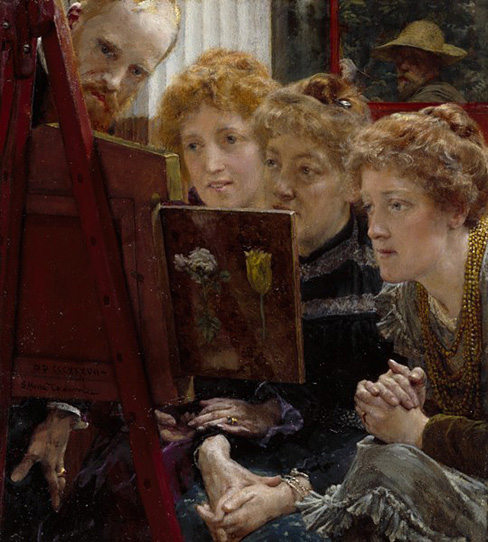
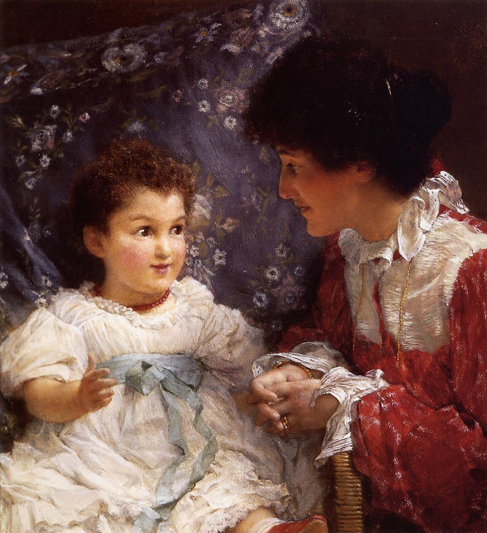
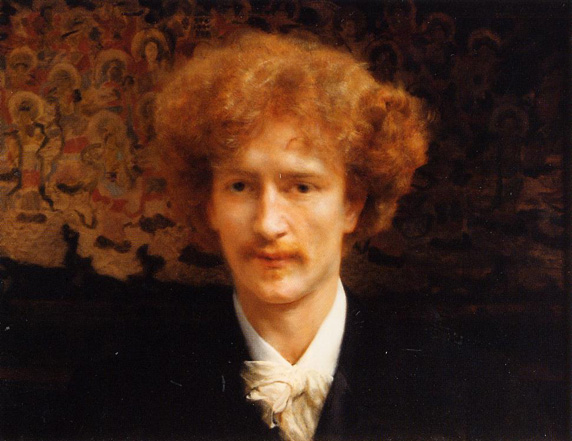
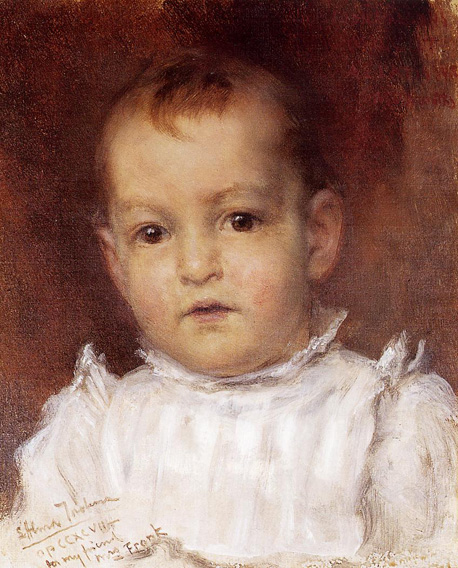
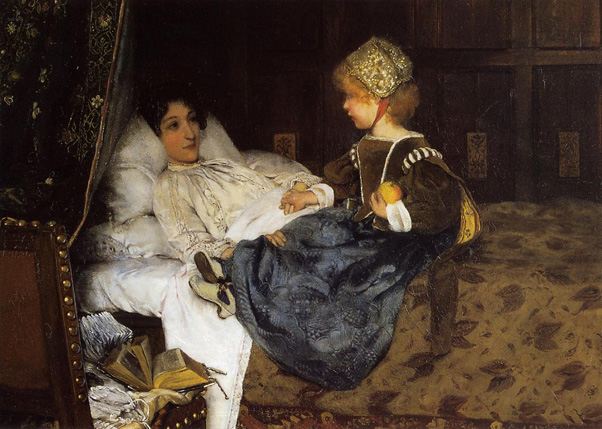
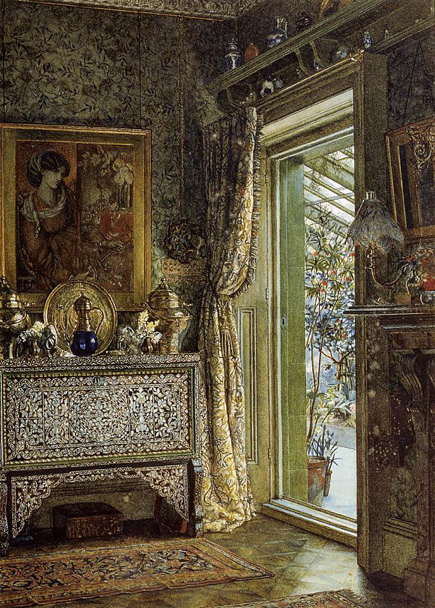
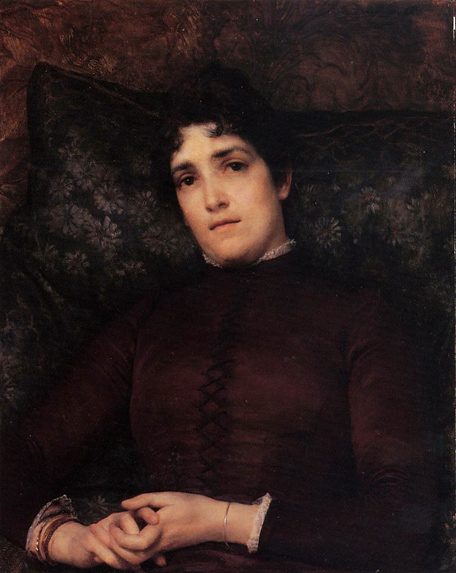
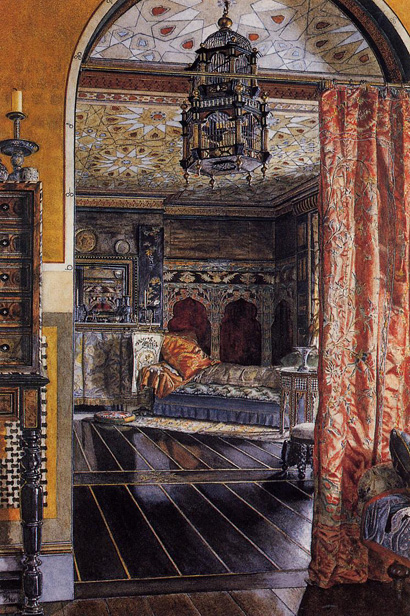
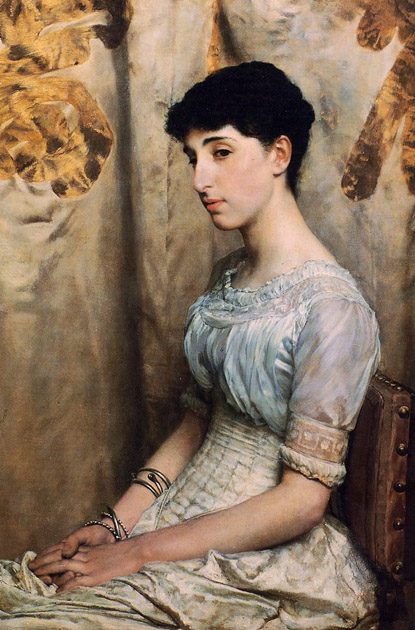
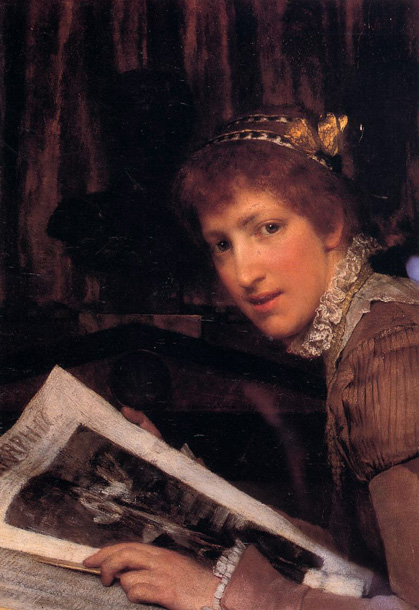
.jpg)
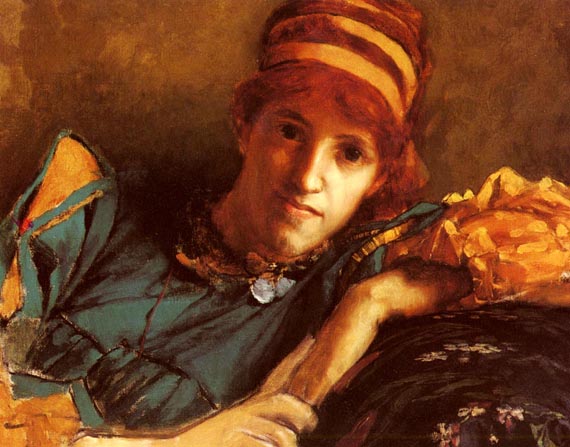
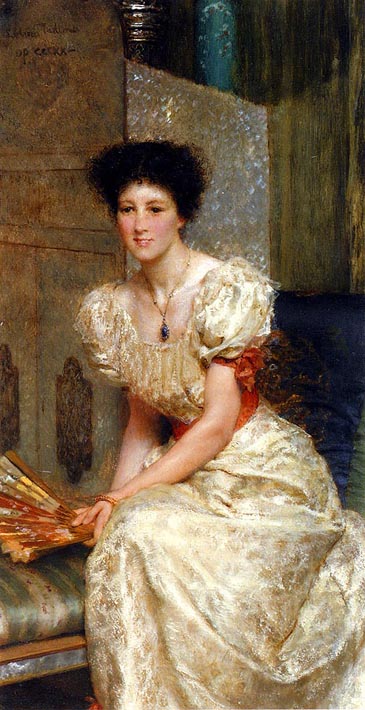
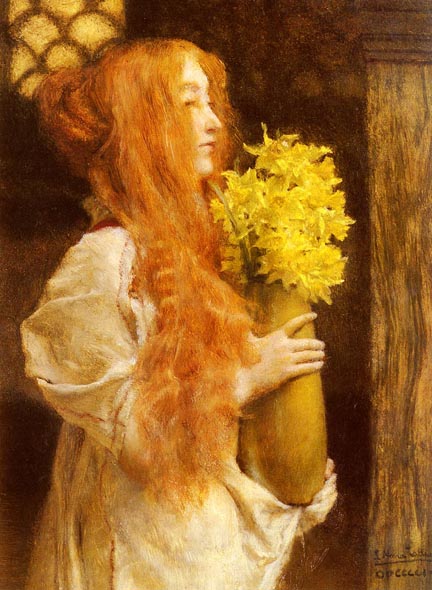
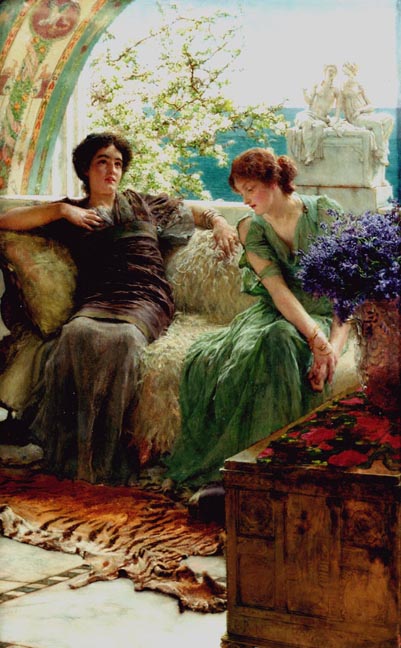
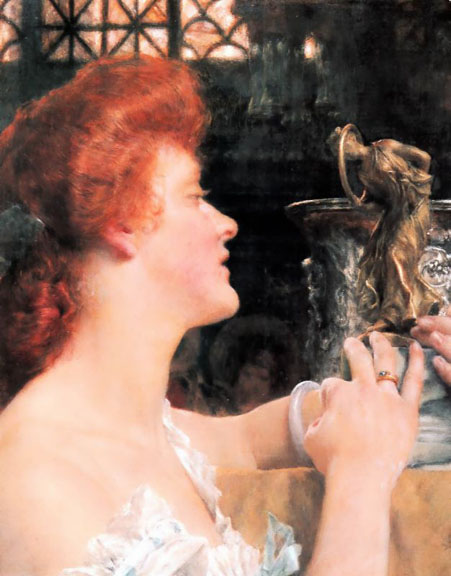
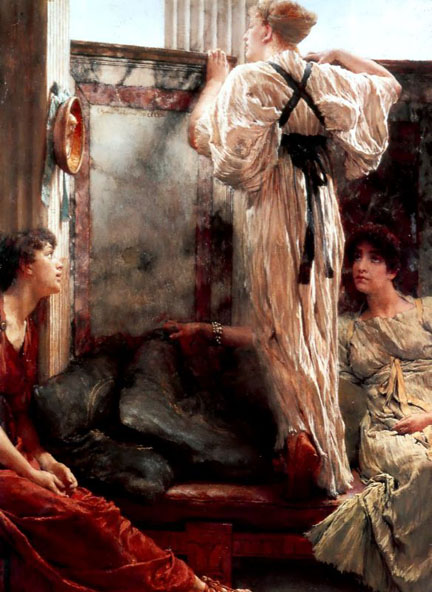
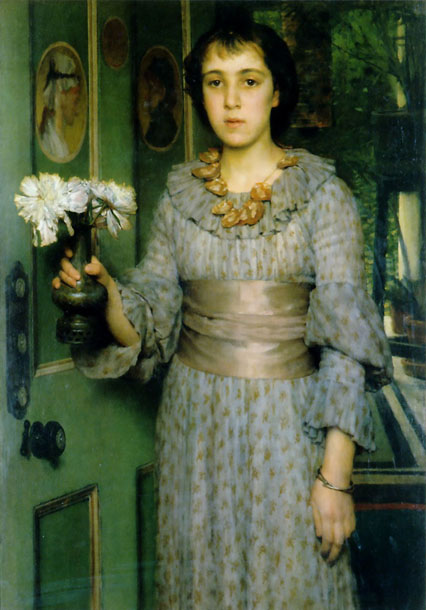

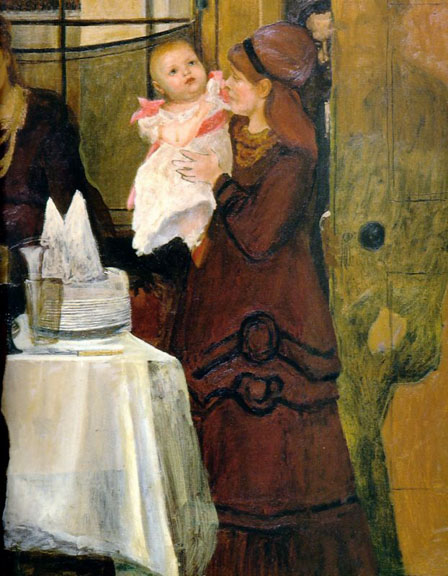
"In order to define Art in connection with Industry I think it will be best to begin by trying to find out what Art is, and 'what is Industry'. Art is as yet an unexplained expression of the human mind. Many lofty aesthetic explanations have been given of it, but none has been quite satisfactory to my mind ... I know it is all a question of sentiment, and I know also how impossible it is to give an adequate description of a sentiment, so that I will not try to define it more precisely for fear of losing myself altogether."
He died in 1912, and was buried in the crypt of St Paul's Cathedral. Some of his many followers include John W Waterhouse, John Collier, and John W Godward. As the Victorian era ended, his work was denounced and his paintings became impossible to sell. After his death he fell into relative obscurity for many years.
"Who knows him well he best can tell
That a stouter friend hath no man
Than this lusty knight, who for our delight
Hath painted Greek and Roman.
Then here let every citizen,
Who holds a brush or wields a pen,
Drink deep as his Zuyder Zee
To Alma-Tad-
Of the Royal Acad-
Of the Royal Academee"
--song to celebrate the painter's knighthood in 1889.
Source: Art Renewal Center
Return to Pagina Artis
Return to Bruce and Bobbie's Main Page.